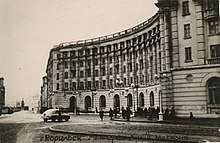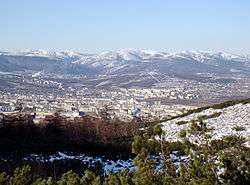Gulag
The Gulag[lower-alpha 3] or GULAG (Russian: ГУЛАГ; acronym for Glavnoe upravlenie lagerei, Главное управление лагерей, 'Main Directorate of Camps')[lower-alpha 4][11][12][13] was the government agency in charge of the Soviet network of forced-labour camps set up by order of Vladimir Lenin, reaching its peak during Joseph Stalin's rule from the 1930s to the early 1950s.[14] English-language speakers also use the word gulag to refer to all forced-labour camps that existed in the Soviet Union, including camps that existed in the post-Stalin era.[15][16]
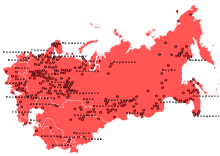 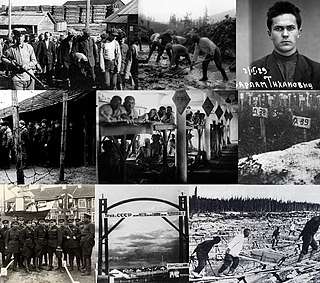
| |
| Main Administration of Camps (1918–1960)[1] | |
|---|---|
|
| Mass repression in the Soviet Union |
|---|
| Economic repression |
| Political repression |
| Ideological repression |
|
| Ethnic repression |
|
| This article is part of a series on the |
| Politics of the Soviet Union |
|---|
 |
|
Leadership |
|
Governance |
The Gulag is recognised as a major instrument of political repression in the Soviet Union. The camps housed a wide range of convicts, from petty criminals to political prisoners, large numbers of whom were convicted by simplified procedures, such as by NKVD troikas or by other instruments of extrajudicial punishment. In 1918–22, the agency was administered by Cheka, followed by the GPU (1922–23), OGPU (1923–34), later by the NKVD (1934–46), and in the final years by the Ministry of Internal Affairs (MVD). The Solovki prison camp, the first corrective labor camp constructed after the revolution, was established in 1918 and legalised by a decree, "On the creation of the forced-labour camps" on April 15, 1919.
The internment system grew rapidly, reaching a population of 100,000 in the 1920s. According to Nicolas Werth, the yearly mortality rate in the Soviet concentration camps strongly varied, reaching 5% (1933) and 20% (1942–1943) while dropping considerably in the post-war years (about 1 to 3% per year at the beginning of the 1950s).[17][18] In 1956 the mortality rate dropped to 0.4%.[19] The emergent consensus among scholars who utilize official archival data is that of the 18 million who were sent to the Gulag from 1930 to 1953, roughly 1.5 to 1.7 million perished there or as a result of their detention.[2][3][4] However, some historians question the reliability of such data and instead rely heavily on literary sources that come to higher estimations.[2][8] Archival researchers have found "no plan of destruction" of the gulag population and no statement of official intent to kill them, and prisoner releases vastly exceeded the number of deaths in the Gulag.[2]
Almost immediately following the death of Stalin, the Soviet establishment took steps in dismantling the Gulag system. A general amnesty was declared in the immediate aftermath of Stalin's death, though it was limited to non-political prisoners and political prisoners sentenced to not more than 5 years. Shortly thereafter Nikita Khrushchev was elected as General Secretary of the Communist Party of the Soviet Union, initiating the processes of de-Stalinization and the Khrushchev Thaw, triggering a mass release and rehabilitation of political prisoners. The Gulag system ended definitively six years later on 25 January 1960, when the remains of the administration were dissolved by Khrushchev. The legal practice of sentencing convicts to penal labour, though restrained, was not fully abolished and continues to this day, although to a far more limited capacity, in the Russian Federation.[20][21]
Aleksandr Solzhenitsyn, winner of the Nobel Prize in Literature, who survived eight years of Gulag incarceration, gave the term its international repute with the publication of The Gulag Archipelago in 1973. The author likened the scattered camps to "a chain of islands," and as an eyewitness he described the Gulag as a system where people were worked to death.[22] In March 1940, there were 53 Gulag camp directorates (colloquially referred to simply as "camps") and 423 labour colonies in the Soviet Union.[5] Many mining and industrial towns and cities in northern and eastern Russia and in Kazakhstan such as Karaganda, Norilsk, Vorkuta and Magadan, were originally blocks of camps built by prisoners and subsequently run by ex-prisoners.[23]
Overview
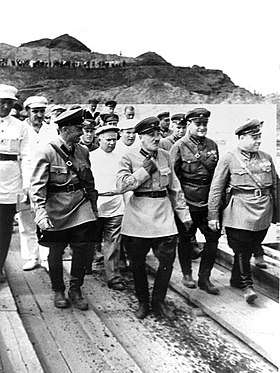
Some suggest that 14 million people were imprisoned in the Gulag labour camps from 1929 to 1953 (the estimates for the period 1918–1929 are more difficult to calculate).[24] Other calculations, by historian Orlando Figes, refer to 25 million prisoners of the Gulag in 1928–1953.[25] A further 6–7 million were deported and exiled to remote areas of the USSR, and 4–5 million passed through labour colonies, plus 3.5 million who were already in, or who had been sent to, labour settlements.[24] According to some estimates, the total population of the camps varied from 510,307 in 1934 to 1,727,970 in 1953.[5] According to other estimates, at the beginning of 1953 the total number of prisoners in prison camps was more than 2.4 million of which more than 465,000 were political prisoners.[26]
GULAG vs. GUPVI
The institutional analysis of the Soviet concentration system is complicated by the formal distinction between GULAG and GUPVI.
GUPVI (ГУПВИ) was the Main Administration for Affairs of Prisoners of War and Internees (Russian: Главное управление по делам военнопленных и интернированных, Glavnoje Upravlenyije po gyelam Vojennoplennih i Internyirovannih), a department of NKVD (later MVD) in charge of handling of foreign civilian internees and POWs (prisoners of war) in the Soviet Union during and in the aftermath of World War II (1939–1953). In many ways the GUPVI system was similar to GULAG.[27] Its major function was the organisation of foreign forced labor in the Soviet Union. The top management of GUPVI came from the GULAG system. The major noted distinction from GULAG was the absence of convicted criminals in the GUPVI camps. Otherwise the conditions in both camp systems were similar: hard labour, poor nutrition and living conditions, and high mortality rate.[28]
For the Soviet political prisoners, like Solzhenitsyn, all foreign civilian detainees and foreign POWs were imprisoned in the GULAG; the surviving foreign civilians and POWs considered themselves prisoners in the GULAG. According with the estimates, in total, during the whole period of the existence of GUPVI there were over 500 POW camps (within the Soviet Union and abroad), which imprisoned over 4,000,000 POW.[29] Most Gulag inmates were not political prisoners, although significant numbers of political prisoners could be found in the camps at any one time.[30]
Petty crimes and jokes about the Soviet government and officials were punishable by imprisonment.[31][32] About half of political prisoners in the Gulag camps were imprisoned without trial; official data suggest that there were over 2.6 million sentences to imprisonment on cases investigated by the secret police throughout 1921–53.[33] The GULAG was reduced in size following Stalin's death in 1953, in a period known as the Khrushchev Thaw.
In 1960, the Ministerstvo Vnutrennikh Del (MVD) ceased to function as the Soviet-wide administration of the camps in favour of individual republic MVD branches. The centralised detention facilities temporarily ceased functioning.[34][35]
Contemporary word usage and other terminology
Although the term Gulag originally referred to a government agency, in English and many other languages the acronym acquired the qualities of a common noun, denoting the Soviet system of prison-based, unfree labour.[36]
Even more broadly, "Gulag" has come to mean the Soviet repressive system itself, the set of procedures that prisoners once called the "meat-grinder": the arrests, the interrogations, the transport in unheated cattle cars, the forced labour, the destruction of families, the years spent in exile, the early and unnecessary deaths.
Western authors use the term Gulag to denote all the prisons and internment camps in the Soviet Union. The term's contemporary usage is at times notably not directly related to the USSR, such as in the expression "North Korea's Gulag"[37] for camps operational today.[38]
The word Gulag was not often used in Russian, either officially or colloquially; the predominant terms were the camps (лагеря, lagerya) and the zone (зона, zona), usually singular, for the labour camp system and for the individual camps. The official term, "corrective labour camp", was suggested for official use by the politburo of the Communist Party of the Soviet Union in the session of July 27, 1929.
History
Background
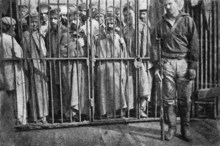
The Tsar and the Russian Empire used both forced exile and forced labour as forms of judicial punishment. Katorga, a category of punishment reserved for those convicted of the most serious crimes, had many of the features associated with labour-camp imprisonment: confinement, simplified facilities (as opposed to prisons), and forced labour, usually involving hard, unskilled or semi-skilled work. According to historian Anne Applebaum, katorga was not a common sentence; approximately 6,000 katorga convicts were serving sentences in 1906 and 28,600 in 1916.[39] Under the Imperial Russian penal system, those convicted of less serious crimes were sent to corrective prisons and also made to work.[40] Forced exile to Siberia had been in use since the seventeenth century for a wide range of offenses and was a common punishment for political dissidents and revolutionaries. In the nineteenth century, the members of the failed Decembrist revolt, Polish nobles who resisted Russian rule, and members of various socialist revolutionary groups, including Bolsheviks such as Sergo Ordzhonikidze, Leon Trotsky, and Joseph Stalin were all sent into exile.[41] Convicts serving labour sentences and exiles were sent to the underpopulated areas of Siberia and the Russian Far East – regions that had few towns or food sources and lacked any organised transportation systems. Despite the isolated conditions, there were prisoners who successfully escaped to populated areas. Stalin himself escaped three of the four times he was sent into exile.[42] From these times, Siberia gained its fearful connotation of punishment, which was further enhanced by the Soviet GULAG system. The Bolsheviks' own experiences with exile and forced labour provided them with a model on which to base their system, including the importance of strict enforcement.
During 1920–50, the leaders of the Communist Party and the Soviet state considered repression to be a tool that was to be used for securing the normal functioning of the Soviet state system, as well as for preserving and strengthening the positions within their social base, the working class (when the Bolsheviks took power, peasants represented 80% of the population).[43] In the midst of the Russian Civil War, Lenin and the Bolsheviks established a "special" prison camp system, separate from its traditional prison system and under the control of the Cheka.[44] These camps, as Lenin envisioned them, had a distinctly political purpose.[45] These early camps of the GULAG system were introduced in order to isolate and eliminate class-alien, socially dangerous, disruptive, suspicious, and other disloyal elements, whose deeds and thoughts were not contributing to the strengthening of the dictatorship of the proletariat.[43] Forced labour as a "method of reeducation" was applied in the Solovki prison camp as early as the 1920s,[46] based on Trotsky's experiments with forced labour camps for Czech war prisoners from 1918 and his proposals to introduce "compulsory labor service" voiced in Terrorism and Communism.[46][47] Various categories of prisoners were defined: petty criminals, POWs of the Russian Civil War, officials accused of corruption, sabotage and embezzlement, political enemies, dissidents and other people deemed dangerous for the state. In the first decade of Soviet rule, the judicial and penal systems were neither unified nor coordinated, and there was a distinction between criminal prisoners and political or "special" prisoners. The "traditional" judicial and prison system, which dealt with criminal prisoners, were first overseen by The People's Commissariat of Justice until 1922, after which they were overseen by the People's Commissariat of Internal Affairs, also known as the NKVD[48]. The Cheka and its successor organisations, the GPU or State Political Directorate and the OGPU, oversaw political prisoners and the "special" camps to which they were sent.[49] In April of 1929, the judicial distinctions between criminal and political prisoners were eliminated, and control of the entire Soviet penal system turned over to the OGPU.[50] In 1928 there were 30,000 individuals interned; the authorities were opposed to compelled labour. In 1927 the official in charge of prison administration wrote:
The exploitation of prison labour, the system of squeezing "golden sweat" from them, the organisation of production in places of confinement, which while profitable from a commercial point of view is fundamentally lacking in corrective significance – these are entirely inadmissible in Soviet places of confinement.[51]
The legal base and the guidance for the creation of the system of "corrective labour camps" (Russian: исправи́тельно-трудовые лагеря, Ispravitel'no-trudovye lagerya), the backbone of what is commonly referred to as the "Gulag", was a secret decree from the Sovnarkom of July 11, 1929, about the use of penal labour that duplicated the corresponding appendix to the minutes of the Politburo meeting of June 27, 1929.
One of the Gulag system founders was Naftaly Frenkel. In 1923 he was arrested for illegally crossing borders and smuggling. He was sentenced to 10 years' hard labor at Solovki, which later came to be known as the "first camp of the Gulag". While serving his sentence he wrote a letter to the camp administration detailing a number of "productivity improvement" proposals including the infamous system of labor exploitation whereas the inmates' food rations were to be linked to their rate of production, a proposal known as nourishment scale (шкала питания). This notorious you-eat-as-you-work system would often kill weaker prisoners in weeks and caused countless casualties. The letter caught the attention of a number of high communist officials including Genrikh Yagoda and Frenkel soon went from being an inmate to becoming a camp commander and an important Gulag official. His proposals soon saw widespread adoption in the Gulag system[52].
After having appeared as an instrument and place for isolating counter-revolutionary and criminal elements, the Gulag, because of its principle of "correction by forced labour", it quickly became, in fact, an independent branch of the national economy secured on the cheap labour force presented by prisoners. Hence it is followed by one more important reason for the constancy of the repressive policy, namely, the state's interest in unremitting rates of receiving a cheap labour force that was forcibly used, mainly in the extreme conditions of the east and north.[43] The Gulag possessed both punitive and economic functions.[53]
Formation and expansion under Stalin
The Gulag was officially established on April 25, 1930 as the ULAG by the OGPU order 130/63 in accordance with the Sovnarkom order 22 p. 248 dated April 7, 1930. It was renamed as the Gulag in November of that year.[1]
The hypothesis that economic considerations were responsible for mass arrests during the period of Stalinism has been refuted on the grounds of former Soviet archives that have become accessible since the 1990s, although some archival sources also tend to support an economic hypothesis.[54][55] In any case, the development of the camp system followed economic lines. The growth of the camp system coincided with the peak of the Soviet industrialisation campaign. Most of the camps established to accommodate the masses of incoming prisoners were assigned distinct economic tasks. These included the exploitation of natural resources and the colonisation of remote areas, as well as the realisation of enormous infrastructural facilities and industrial construction projects. The plan to achieve these goals with "special settlements" instead of labor camps was dropped after the revealing of the Nazino affair in 1933; subsequently the Gulag system was expanded.
The 1931–32 archives indicate the Gulag had approximately 200,000 prisoners in the camps; while in 1935, approximately 800,000 were in camps and 300,000 in colonies (annual averages).[56]
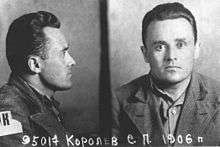
In the early 1930s, a tightening of Soviet penal policy caused significant growth of the prison camp population.[57] During the Great Purge of 1937–38, mass arrests caused another increase in inmate numbers. Hundreds of thousands of persons were arrested and sentenced to long prison terms on the grounds of one of the multiple passages of the notorious Article 58 of the Criminal Codes of the Union republics, which defined punishment for various forms of "counterrevolutionary activities". Under NKVD Order No. 00447, tens of thousands of Gulag inmates were executed in 1937–38 for "continuing counterrevolutionary activities".
Between 1934 and 1941, the number of prisoners with higher education increased more than eight times, and the number of prisoners with high education increased five times.[43] It resulted in their increased share in the overall composition of the camp prisoners.[43] Among the camp prisoners, the number and share of the intelligentsia was growing at the quickest pace.[43] Distrust, hostility, and even hatred for the intelligentsia was a common characteristic of the Soviet leaders.[43] Information regarding the imprisonment trends and consequences for the intelligentsia derive from the extrapolations of Viktor Zemskov from a collection of prison camp population movements data.[43][58]
Early years of Stalin's Gulag (1929–31)
The gulag was an administration body that watched over the camps; eventually its name would be used for these camps retrospectively. After Lenin's death in 1924, Stalin was able to take control of the government, and began to form the gulag system. On June 27, 1929 the Politburo created a system of self-supporting camps that would eventually replace the existing prisons around the country.[59] These prisons were meant to receive inmates that received a prison sentence that exceeded three years. Prisoners that had a shorter prison sentence than three years were to remain in the prison system that was still under the purview of the NKVD. The purpose of these new camps was to colonise the remote and inhospitable environments throughout the Soviet Union. These changes took place around the same time that Stalin started to institute collectivisation and rapid industrial development. Collectivisation resulted in a large scale purge of peasants and so-called Kulaks. The Kulaks were supposedly wealthy (comparatively to other Soviet peasants) and were considered to be capitalists by the state, and by extension enemies of socialism. The term would also become associated with anyone who opposed or even seemed unsatisfied with the Soviet government.
Dekulakisation
By late 1929 Stalin began a program known as dekulakization. Stalin demanded that the kulak class be completely wiped out, resulting in the imprisonment and execution of Soviet peasants. In a mere four months, 60,000 people being sent to the camps and another 154,000 exiled. This was only the beginning of the dekulakisation process, however. In 1931 alone 1,803,392 people were exiled.[60]
Although these massive relocation processes were successful in getting a large potential free forced labour work force where they needed to be, that is about all it was successful at doing. The "special settlers", as the Soviet government referred to them, all lived on starvation level rations, and many people starved to death in the camps, and anyone who was healthy enough to escape tried to do just that. This resulted in the government having to give rations to a group of people they were getting hardly any use out of, and was just costing the Soviet government money. The Unified State Political Administration (OGPU) quickly realised the problem, and began to reform the dekulakisation process. To help prevent the mass escapes the OGPU started to recruit people within the colony to help stop people who attempted to leave, and set up ambushes around known popular escape routes. The OGPU also attempted to raise the living conditions in these camps that would not encourage people to actively try and escape, and Kulaks were promised that they would regain their rights after five years. Even these revisions ultimately failed to resolve the problem, and the dekulakisation process was a failure in providing the government with a steady forced labour force. These prisoners were also lucky to be in the gulag in the early 1930s. Prisoners were relatively well off compared to what the prisoners would have to go through in the final years of the gulag.[61]
During World War II
Political role
On the eve of World War II, Soviet archives indicate a combined camp and colony population upwards of 1.6 million in 1939, according to V. P. Kozlov.[56] Anne Applebaum and Steven Rosefielde estimate that 1.2 to 1.5 million people were in Gulag system's prison camps and colonies when the war started.[62][63]
After the German invasion of Poland that marked the start of World War II in Europe, the Soviet Union invaded and annexed eastern parts of the Second Polish Republic. In 1940 the Soviet Union occupied Estonia, Latvia, Lithuania, Bessarabia (now the Republic of Moldova) and Bukovina. According to some estimates, hundreds of thousands of Polish citizens[64][65] and inhabitants of the other annexed lands, regardless of their ethnic origin, were arrested and sent to the Gulag camps. However, according to the official data, the total number of sentences for political and anti-state (espionage, terrorism) crimes in USSR in 1939–41 was 211,106.[33]
Approximately 300,000 Polish prisoners of war were captured by the USSR during and after the "Polish Defensive War".[66] Almost all of the captured officers and a large number of ordinary soldiers were then murdered (see Katyn massacre) or sent to Gulag.[67] Of the 10,000–12,000 Poles sent to Kolyma in 1940–41, most prisoners of war, only 583 men survived, released in 1942 to join the Polish Armed Forces in the East.[68] Out of General Anders' 80,000 evacuees from Soviet Union gathered in Great Britain only 310 volunteered to return to Soviet-controlled Poland in 1947.[69]
During the Great Patriotic War, Gulag populations declined sharply due to a steep rise in mortality in 1942–43. In the winter of 1941 a quarter of the Gulag's population died of starvation.[70] 516,841 prisoners died in prison camps in 1941–43,[71][72] from a combination of their harsh working conditions and the famine caused by the German invasion. This period accounts for about half of all gulag deaths, according to Russian statistics.
In 1943, the term katorga works (каторжные работы) was reintroduced. They were initially intended for Nazi collaborators, but then other categories of political prisoners (for example, members of deported peoples who fled from exile) were also sentenced to "katorga works". Prisoners sentenced to "katorga works" were sent to Gulag prison camps with the most harsh regime and many of them perished.[72]
Economic role
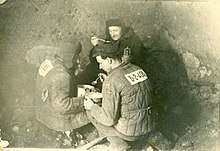
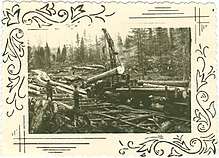
Up until World War II, the Gulag system expanded dramatically to create a Soviet "camp economy". Right before the war, forced labour provided 46.5% of the nation's nickel, 76% of its tin, 40% of its cobalt, 40.5% of its chrome-iron ore, 60% of its gold, and 25.3% of its timber.[73] And in preparation for war, the NKVD put up many more factories and built highways and railroads.
The Gulag quickly switched to production of arms and supplies for the army after fighting began. At first, transportation remained a priority. In 1940 the NKVD focused most of its energy on railroad construction.[74] This would prove extremely important when the German advance into the Soviet Union started in 1941. In addition, factories converted to produce ammunition, uniforms, and other supplies. Moreover, the NKVD gathered skilled workers and specialists from throughout the Gulag into 380 special colonies which produced tanks, aircraft, armaments, and ammunition.[73]
Despite its low capital costs, the camp economy suffered from serious flaws. For one, actual productivity almost never matched estimates: the estimates proved far too optimistic. In addition, scarcity of machinery and tools plagued the camps, and the tools that the camps did have quickly broke. The Eastern Siberian Trust of the Chief Administration of Camps for Highway Construction destroyed ninety-four trucks in just three years.[75] But the greatest problem was simple – forced labour was less efficient than free labour. In fact, prisoners in the Gulag were, on average, half as productive as free labourers in the USSR at the time,[73] which may be partially explained by malnutrition.
To make up for this disparity, the NKVD worked prisoners harder than ever. To meet rising demand, prisoners worked longer and longer hours, and on lower food-rations than ever before. A camp administrator said in a meeting: "There are cases when a prisoner is given only four or five hours out of twenty-four for rest, which significantly lowers his productivity." In the words of a former Gulag prisoner: "By the spring of 1942, the camp ceased to function. It was difficult to find people who were even able to gather firewood or bury the dead."[73] The scarcity of food stemmed in part from the general strain on the entire Soviet Union, but also lack of central aid to the Gulag during the war. The central government focused all its attention on the military, and left the camps to their own devices. In 1942 the Gulag set up the Supply Administration to find their own food and industrial goods. During this time, not only did food become scarce, but the NKVD limited rations in an attempt to motivate the prisoners to work harder for more food, a policy that lasted until 1948.[76]
In addition to food shortages, the Gulag suffered from labour scarcity at the beginning of the war. The Great Terror of 1936–1938 had provided a large supply of free labour, but by the start of World War II the purges had slowed down. In order to complete all of their projects, camp administrators moved prisoners from project to project.[74] To improve the situation, laws were implemented in mid-1940 that allowed giving short camp sentences (4 months or a year) to those convicted of petty theft, hooliganism, or labour-discipline infractions. By January 1941 the Gulag workforce had increased by approximately 300,000 prisoners.[74] But in 1942 serious food shortages began, and camp populations dropped again. The camps lost still more prisoners to the war effort. (The Soviet Union went into total war footing in June 1941.) Many labourers received early releases so that they could be drafted and sent to the front.[76]
Even as the pool of workers shrank, demand for outputs continued to grow rapidly. As a result, the Soviet government pushed the Gulag to "do more with less". With fewer able-bodied workers and few supplies from outside the camp system, camp administrators had to find a way to maintain production. The solution they found was to push the remaining prisoners still harder. The NKVD employed a system of setting unrealistically high production goals, straining resources in an attempt to encourage higher productivity. As the Axis armies pushed into Soviet territory from June 1941 on, labour resources became further strained, and many of the camps had to evacuate out of Western Russia. From the beginning of the war to halfway through 1944, 40 camps were set up, and 69 were disbanded. During evacuations, machinery received priority, leaving prisoners to reach safety on foot. The speed of Operation Barbarossa's advance prevented the evacuation of all labourers in good time, and the NKVD massacred many to prevent them from falling into German hands. While this practice denied the Germans a source of free labour, it also further restricted the Gulag's capacity to keep up with the Red Army's demands. When the tide of the war turned, however, and the Soviets started pushing the Axis invaders back, fresh batches of labourers replenished the camps. As the Red Army recaptured territories from the Germans, an influx of Soviet ex-POWs greatly increased the Gulag population.[76]
After World War II
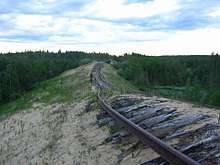
After World War II the number of inmates in prison camps and colonies, again, rose sharply, reaching approximately 2.5 million people by the early 1950s (about 1.7 million of whom were in camps).
When the war in Europe ended in May 1945, as many as two million former Russian citizens were forcefully repatriated into the USSR.[77] On February 11, 1945, at the conclusion of the Yalta Conference, the United States and United Kingdom signed a Repatriation Agreement with the Soviet Union.[78] One interpretation of this agreement resulted in the forcible repatriation of all Soviets. British and U.S. civilian authorities ordered their military forces in Europe to deport to the Soviet Union up to two million former residents of the Soviet Union, including persons who had left the Russian Empire and established different citizenship years before. The forced repatriation operations took place from 1945–47.[79]
Multiple sources state that Soviet POWs, on their return to the Soviet Union, were treated as traitors (see Order No. 270).[80][81][82] According to some sources, over 1.5 million surviving Red Army soldiers imprisoned by the Germans were sent to the Gulag.[83][84][85] However, that is a confusion with two other types of camps. During and after World War II, freed POWs went to special "filtration" camps. Of these, by 1944, more than 90 percent were cleared, and about 8 percent were arrested or condemned to penal battalions. In 1944, they were sent directly to reserve military formations to be cleared by the NKVD. Further, in 1945, about 100 filtration camps were set for repatriated Ostarbeiter, POWs, and other displaced persons, which processed more than 4,000,000 people. By 1946, the major part of the population of these camps were cleared by NKVD and either sent home or conscripted (see table for details).[86] 226,127 out of 1,539,475 POWs were transferred to the NKVD, i.e. the Gulag.[86][87]
| Category | Total | % | Civilian | % | POWs | % |
|---|---|---|---|---|---|---|
| Released and sent home[lower-alpha 5] | 2,427,906 | 57.81 | 2,146,126 | 80.68 | 281,780 | 18.31 |
| Conscripted | 801,152 | 19.08 | 141,962 | 5.34 | 659,190 | 42.82 |
| Sent to labour battalions of the Ministry of Defence | 608,095 | 14.48 | 263,647 | 9.91 | 344,448 | 22.37 |
| Sent to NKVD as spetskontingent[lower-alpha 6] (i.e. sent to GULAG) | 272,867 | 6.50 | 46,740 | 1.76 | 226,127 | 14.69 |
| Were waiting for transportation and worked for Soviet military units abroad | 89,468 | 2.13 | 61,538 | 2.31 | 27,930 | 1.81 |
| Total | 4,199,488 | 100 | 2,660,013 | 100 | 1,539,475 | 100 |
After Nazi Germany's defeat, ten NKVD-run "special camps" subordinate to the Gulag were set up in the Soviet Occupation Zone of post-war Germany. These "special camps" were former Stalags, prisons, or Nazi concentration camps such as Sachsenhausen (special camp number 7) and Buchenwald (special camp number 2). According to German government estimates "65,000 people died in those Soviet-run camps or in transportation to them."[88] According to German researchers, Sachsenhausen, where 12,500 Soviet era victims have been uncovered, should be seen as an integral part of the Gulag system.[89]
Yet the major reason for the post-war increase in the number of prisoners was the tightening of legislation on property offences in summer 1947 (at this time there was a famine in some parts of the Soviet Union, claiming about 1 million lives), which resulted in hundreds of thousands of convictions to lengthy prison terms, sometimes on the basis of cases of petty theft or embezzlement. At the beginning of 1953 the total number of prisoners in prison camps was more than 2.4 million of which more than 465,000 were political prisoners.[72]
The state continued to maintain the extensive camp system for a while after Stalin's death in March 1953, although the period saw the grip of the camp authorities weaken, and a number of conflicts and uprisings occur (see Bitch Wars; Kengir uprising; Vorkuta uprising).
The amnesty in March 1953 was limited to non-political prisoners and for political prisoners sentenced to not more than 5 years, therefore mostly those convicted for common crimes were then freed. The release of political prisoners started in 1954 and became widespread, and also coupled with mass rehabilitations, after Nikita Khrushchev's denunciation of Stalinism in his Secret Speech at the 20th Congress of the CPSU in February 1956.
The Gulag institution was closed by the MVD order No 020 of January 25, 1960[1] but forced labor colonies for political and criminal prisoners continued to exist. Political prisoners continued to be kept in one of the most famous camps Perm-36[90] until 1987 when it was closed.[91] (See also Foreign forced labor in the Soviet Union.)
The Russian penal system, despite reforms and a reduction in prison population, informally or formally continues many practices endemic to the Gulag system, including forced labour, inmates policing inmates, and prisoner intimidation.[21]
In the late 2000s, some human rights activists accused authorities of gradual removal of Gulag remembrance from places such as Perm-36 and Solovki prison camp.[92]
Death toll
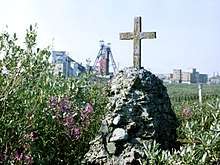
Prior to the dissolution of the Soviet Union, estimates of Gulag victims ranged from 2.3 to 17.6 million (see a History of Gulag population estimates section). Mortality in Gulag camps in 1934–40 was 4–6 times higher than average in the Soviet Union. Post-1991 research by historians accessing archival materials brought this range down considerably.[93][94] According to a 1993 study of archival Soviet data, a total of 1,053,829 people died in the Gulag from 1934 to 1953.[5]:1024 However, taking into account the fact that it was common practice to release prisoners who were either suffering from incurable diseases or near death,[95][96] a combined statistics on mortality in the camps and mortality caused by the camps gives a probable figure around 1.6 million.[3][4] In contrast Anatoly Vishnevsky estimated total number of those who died in imprisonment in 1930–53 is at least 1.76 million, about half of which occurred between 1941–43 following the German invasion.[97][98] If prisoner deaths from labor colonies and special settlements are included, the death toll according to J. Otto Pohl rises to 2,749,163, although the historian who compiled this estimate (J. Otto Pohl) stresses that it is incomplete, and doesn't cover all prisoner categories for every year.[96][6]
In her recent study, Golfo Alexopoulos attempted to challenge this consensus figure by encompassing those whose life was shortened due to GULAG conditions.[2] Alexopoulos concluded from her research that a systematic practice of the Gulag was to release sick prisoners on the verge of death; and that all prisoners who received the health classification "invalid," "light physical labour," "light individualised labour," or "physically defective" that together according to Alexopoulos encompassed at least one third of all inmates who passed through the Gulag died or had their lives shortened due to detention in the Gulag in captivity or shortly after release.[99] The GULAG mortality estimated in this way yields the figure of 6 million deaths.[7] Historian Orlando Figes and Russian writer Vadim Erlikman have posited similar estimates.[8][9] The estimate of Alexopoulos however; has obvious methodological difficulties[2] and is supported by misinterpreted evidence such as presuming that hundreds of thousands of prisoners “directed to other places of detention” in 1948 was a euphemism for releasing prisoners on the verge of death into labour colonies, when it was really referring to internal transport in the Gulag rather than release.[100]
The tentative historical consensus among archival researchers and historians who access such data is that of the 18 million people who passed through the gulag from 1930 to 1953, is that at least[100] between 1.5 and 1.7 million perished as a result of their detention[2] though some historians believe the actual death toll is "somewhat higher."[100]
Mortality rate
Certificates of death in the Gulag system for the period from 1930 to 1956.[19]
| Year | Deaths | Mortality rate % |
|---|---|---|
| 1930 | 7 980 | 4,2 |
| 1931 | 7 283 | 2,9 |
| 1932 | 13 197 | 4,8 |
| 1933 | 67 297 | 15,3 |
| 1934 | 25 187 | 4,28 |
| 1935 | 31 636 | 2,75 |
| 1936 | 24 993 | 2,11 |
| 1937 | 31 056 | 2,42 |
| 1938 | 108 654 | 5,35 |
| 1939 | 44 750 | 3,1 |
| 1940 | 41 275 | 2,72 |
| 1941 | 115 484 | 6,1 |
| 1942 | 352 560 | 24,9 |
| 1943 | 267 826 | 22,4 |
| 1944 | 114 481 | 9,2 |
| 1945 | 81 917 | 5,95 |
| 1946 | 30 715 | 2,2 |
| 1947 | 66 830 | 3,59 |
| 1948 | 50 659 | 2,28 |
| 1949 | 29 350 | 1,21 |
| 1950 | 24 511 | 0,95 |
| 1951 | 22 466 | 0,92 |
| 1952 | 20 643 | 0,84 |
| 1953 | 9 628 | 0,67 |
| 1954 | 8 358 | 0,69 |
| 1955 | 4 842 | 0,53 |
| 1956 | 3 164 | 0,4 |
| Total | 1 606 748 |
Gulag administrators
| Name | Years[101][102][103] |
|---|---|
| Feodor (Teodors) Ivanovich Eihmans | April 25, 1930 – June 16, 1930 |
| Lazar Iosifovich Kogan | June 16, 1930 – June 9, 1932 |
| Matvei Davidovich Berman | June 9, 1932 – August 16, 1937 |
| Israel Israelevich Pliner | August 16, 1937 – November 16, 1938 |
| Gleb Vasilievich Filaretov | November 16, 1938 – February 18, 1939 |
| Vasili Vasilievich Chernyshev | February 18, 1939 – February 26, 1941 |
| Victor Grigorievich Nasedkin | February 26, 1941 – September 2, 1947 |
| Georgy Prokopievich Dobrynin | September 2, 1947 – January 31, 1951 |
| Ivan Ilyich Dolgich | January 31, 1951 – October 5, 1954 |
| Sergei Yegorovich Yegorov | October 5, 1954 – April 4, 1956 |
Conditions
Living and working conditions in the camps varied significantly across time and place, depending, among other things, on the impact of broader events (World War II, countrywide famines and shortages, waves of terror, sudden influx or release of large numbers of prisoners). However, to one degree or another, the large majority of prisoners at most times faced meagre food rations, inadequate clothing, overcrowding, poorly insulated housing, poor hygiene, and inadequate health care. Most prisoners were compelled to perform harsh physical labour.[104] In most periods and economic branches, the degree of mechanisation of work processes was significantly lower than in the civilian industry: tools were often primitive and machinery, if existent, short in supply. Officially established work hours were in most periods longer and days off were fewer than for civilian workers.
Andrei Vyshinsky, procurator of the Soviet Union, wrote a memorandum to NKVD chief Nikolai Yezhov in 1938 which stated:[105]
Among the prisoners there are some so ragged and lice-ridden that they pose a sanitary danger to the rest. These prisoners have deteriorated to the point of losing any resemblance to human beings. Lacking food…they collect orts [refuse] and, according to some prisoners, eat rats and dogs.
In general, the central administrative bodies showed a discernible interest in maintaining the labour force of prisoners in a condition allowing the fulfilment of construction and production plans handed down from above. Besides a wide array of punishments for prisoners refusing to work (which, in practice, were sometimes applied to prisoners that were too enfeebled to meet production quota), they instituted a number of positive incentives intended to boost productivity. These included monetary bonuses (since the early 1930s) and wage payments (from 1950 onward), cuts of individual sentences, general early-release schemes for norm fulfilment and overfulfilment (until 1939, again in selected camps from 1946 onward), preferential treatment, and privileges for the most productive workers (shock workers or Stakhanovites in Soviet parlance).[106]
A distinctive incentive scheme that included both coercive and motivational elements and was applied universally in all camps consisted in standardised "nourishment scales": the size of the inmates' ration depended on the percentage of the work quota delivered. Naftaly Frenkel is credited for the introduction of this policy. While it was effective in compelling many prisoners to work harder, for many a prisoner it had the adverse effect, accelerating the exhaustion and sometimes causing the death of persons unable to fulfil high production quota.
Immediately after the German attack on the Soviet Union in June 1941 the conditions in camps worsened drastically: quotas were increased, rations cut, and medical supplies came close to none, all of which led to a sharp increase in mortality. The situation slowly improved in the final period and after the end of the war.
Considering the overall conditions and their influence on inmates, it is important to distinguish three major strata of Gulag inmates:
- Kulaks, osadniks, ukazniks (people sentenced for violation of various ukases, e.g. Law of Spikelets, decree about work discipline, etc.), occasional violators of criminal law
- Dedicated criminals: "thieves in law"
- People sentenced for various political and religious reasons.
Gulag and famine (1932–33)
A severe famine of 1931–1933 swept across many different regions in the Soviet Union. During this time, it is estimated that around six to seven million people starved to death.[107] On 7 August 1932, a new edict drafted by Stalin specified a minimum sentence of ten years or execution for theft from collective farms or of cooperative property. Over the next few months, prosecutions rose fourfold. A large share of cases prosecuted under the law were for the theft of small quantities of grain worth less than fifty rubles. The law was later relaxed on 8 May 1933.[108] Overall, during the first half of 1933, prisons saw more new incoming inmates than the three previous years combined.
Prisoners in the camps faced harsh working conditions. One Soviet report stated that, in early 1933, up to 15% of the prison population in Soviet Uzbekistan died monthly. During this time, prisoners were getting around 300 calories (1,300 kJ) worth of food a day. Many inmates attempted to flee, causing an upsurge in coercive and violent measures. Camps were directed "not to spare bullets".[109] The bodies of inmates who tried to escape were commonly displayed in the courtyards of the camps, and the administrators would forcibly escort the inmates around the dead bodies as a message. Until 1934, lack of food and the outbreak of diseases started to destabilise the Gulag system. It wasn't until the famine ended that the system started to stabilize.
Social conditions
The convicts in such camps were actively involved in all kinds of labour with one of them being logging (lesopoval). The working territory of logging presented by itself a square and was surrounded by forest clearing. Thus, all attempts to exit or escape from it were well observed from the four towers set at each of its corners.
Locals who captured a runaway were given rewards.[110] It is also said that camps in colder areas were less concerned with finding escaped prisoners as they would die anyhow from the severely cold winters. In such cases prisoners who did escape without getting shot were often found dead kilometres away from the camp.
Geography
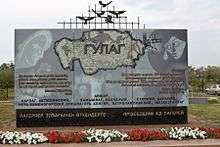
In the early days of Gulag, the locations for the camps were chosen primarily for the isolated conditions involved. Remote monasteries in particular were frequently reused as sites for new camps. The site on the Solovetsky Islands in the White Sea is one of the earliest and also most noteworthy, taking root soon after the Revolution in 1918.[22] The colloquial name for the islands, "Solovki", entered the vernacular as a synonym for the labor camp in general. It was presented to the world as an example of the new Soviet method for "re-education of class enemies" and reintegrating them through labor into Soviet society. Initially the inmates, largely Russian intelligentsia, enjoyed relative freedom (within the natural confinement of the islands). Local newspapers and magazines were published and even some scientific research was carried out (e.g., a local botanical garden was maintained but unfortunately later lost completely). Eventually Solovki turned into an ordinary Gulag camp; in fact some historians maintain that it was a pilot camp of this type. In 1929 Maxim Gorky visited the camp and published an apology for it. The report of Gorky's trip to Solovki was included in the cycle of impressions titled "Po Soiuzu Sovetov," Part V, subtitled "Solovki." In the report, Gorky wrote that "camps such as 'Solovki' were absolutely necessary."[111]
With the new emphasis on Gulag as the means of concentrating cheap labour, new camps were then constructed throughout the Soviet sphere of influence, wherever the economic task at hand dictated their existence (or was designed specifically to avail itself of them, such as the White Sea-Baltic Canal or the Baikal Amur Mainline), including facilities in big cities — parts of the famous Moscow Metro and the Moscow State University new campus were built by forced labor. Many more projects during the rapid industrialisation of the 1930s, war-time and post-war periods were fulfilled on the backs of convicts. The activity of Gulag camps spanned a wide cross-section of Soviet industry. Gorky organised in 1933 a trip of 120 writers and artists to the White Sea–Baltic Canal, 36 of them wrote a propaganda book about the construction published in 1934 and destroyed in 1937.
The majority of Gulag camps were positioned in extremely remote areas of northeastern Siberia (the best known clusters are Sevvostlag (The North-East Camps) along Kolyma river and Norillag near Norilsk) and in the southeastern parts of the Soviet Union, mainly in the steppes of Kazakhstan (Luglag, Steplag, Peschanlag). A very precise map was made by the Memorial Foundation.[112] These were vast and sparsely inhabited regions with no roads (in fact, the construction of the roads themselves was assigned to the inmates of specialised railway camps) or sources of food, but rich in minerals and other natural resources (such as timber). However, camps were generally spread throughout the entire Soviet Union, including the European parts of Russia, Belarus, and Ukraine. There were several camps outside the Soviet Union, in Czechoslovakia, Hungary, Poland, and Mongolia, which were under the direct control of the Gulag.
Not all camps were fortified; some in Siberia were marked only by posts. Escape was deterred by the harsh elements, as well as tracking dogs that were assigned to each camp. While during the 1920s and 1930s native tribes often aided escapees, many of the tribes were also victimised by escaped thieves. Tantalised by large rewards as well, they began aiding authorities in the capture of Gulag inmates. Camp guards were given stern incentive to keep their inmates in line at all costs; if a prisoner escaped under a guard's watch, the guard would often be stripped of his uniform and become a Gulag inmate himself. Further, if an escaping prisoner was shot, guards could be fined amounts that were often equivalent to one or two weeks wages.
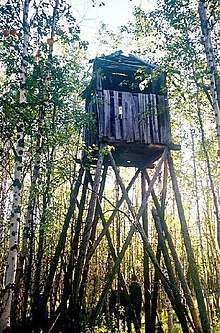
In some cases, teams of inmates were dropped off in new territory with a limited supply of resources and left to set up a new camp or die. Sometimes it took several waves of colonists before any one group survived to establish the camp.
The area along the Indigirka river was known as the Gulag inside the Gulag. In 1926, the Oimiakon (Оймякон) village in this region registered the record low temperature of −71.2 °C (−96 °F).
Under the supervision of Lavrenty Beria who headed both NKVD and the Soviet atom bomb program until his demise in 1953, thousands of zeks (Gulag inmates) were used to mine uranium ore and prepare test facilities on Novaya Zemlya, Vaygach Island, Semipalatinsk, among other sites.
Throughout the history of the Soviet Union, there were at least 476 separate camp administrations.[113][114] The Russian researcher Galina Ivanova stated that,[114]
to date, Russian historians have discovered and described 476 camps that existed at different times on the territory of the USSR. It is well known that practically every one of them had several branches, many of which were quite large. In addition to the large numbers of camps, there were no less than 2,000 colonies. It would be virtually impossible to reflect the entire mass of Gulag facilities on a map that would also account for the various times of their existence.
Since many of these existed only for short periods, the number of camp administrations at any given point was lower. It peaked in the early 1950s, when there were more than 100 camp administrations across the Soviet Union. Most camp administrations oversaw several single camp units, some as many as dozens or even hundreds.[115] The infamous complexes were those at Kolyma, Norilsk, and Vorkuta, all in arctic or subarctic regions. However, prisoner mortality in Norilsk in most periods was actually lower than across the camp system as a whole.[116]
Special institutions
- There were separate camps or zones within camps for juveniles (малолетки, maloletki), the disabled (in Spassk), and mothers (мамки, mamki) with babies.
- Family members of "Traitors of the Motherland" (ЧСИР, член семьи изменника Родины, ChSIR, Chlyen sem'i izmennika Rodini) were placed under a special category of repression.
- Secret research laboratories known as Sharashka (шарашка) held arrested and convicted scientists, some of them prominent, where they anonymously developed new technologies and also conducted basic research.
Historiography
Origins and functions of the Gulag
According to historian Stephen Barnes, there exist four major ways of looking at the origins and functions of the Gulag:[117]
- The first approach was championed by Alexander Solzhenitsyn, and is what Barnes terms the moral explanation. According to this view, Soviet ideology eliminated the moral checks on the darker side of human nature – providing convenient justifications for violence and evil-doing on all levels: from political decision-making to personal relations.
- Another approach is the political explanation, according to which the Gulag (along with executions) was primarily a means for eliminating the regime's perceived political enemies (this understanding is favoured by historian Robert Conquest, amongst others).
- The economic explanation, in turn as set out by historian Anne Applebaum, argues that the Soviet regime instrumentalised the Gulag for its economic development projects. Although never economically profitable, it was perceived as such right up to Stalin's death in 1953.
- Finally, Barnes advances his own, fourth explanation, which situates the Gulag in the context of modern projects of 'cleansing' the social body of hostile elements, through spatial isolation and physical elimination of individuals defined as harmful.
Hannah Arendt argues that as part of a totalitarian system of government, the camps of the Gulag system were experiments in "total domination." In her view, the goal of a totalitarian system was not merely to establish limits on liberty, but rather to abolish liberty entirely in service of its ideology. She argues that the Gulag system was not merely political repression because the system survived and grew long after Stalin had wiped out all serious political resistance. Although the various camps were initially filled with criminals and political prisoners, eventually they were filled with prisoners who were arrested irrespective of anything relating to them as individuals, but rather only on the basis of their membership in some ever shifting category of imagined threats to the state.[118]:437–59
She also argues that the function of the Gulag system was not truly economic. Although the Soviet government deemed them all "forced labour" camps, this in fact highlighted that the work in the camps was deliberately pointless, since all Russian workers could be subject to forced labour.[118]:444–5 The only real economic purpose they typically served was financing the cost of their own supervision. Otherwise the work performed was generally useless, either by design or made that way through extremely poor planning and execution; some workers even preferred more difficult work if it was actually productive. She differentiated between "authentic" forced-labour camps, concentration camps, and "annihilation camps". In authentic labour camps, inmates worked in "relative freedom and are sentenced for limited periods." Concentration camps had extremely high mortality rates and but were still "essentially organised for labour purposes." Annihilation camps were those where the inmates were "systematically wiped out through starvation and neglect." She criticises other commentators' conclusion that the purpose of the camps was a supply of cheap labour. According to her, the Soviets were able to liquidate the camp system without serious economic consequences, showing that the camps were not an important source of labour and were overall economically irrelevant.[118]:444–5
Arendt argues that together with the systematised, arbitrary cruelty inside the camps, this served the purpose of total domination by eliminating the idea that the arrestees had any political or legal rights. Morality was destroyed by maximising cruelty and by organising the camps internally to make the inmates and guards complicit. The terror resulting from operation of the Gulag system caused people outside of the camps to cut all ties with anyone who was arrested or purged and to avoid forming ties with others for fear of being associated with anyone who was targeted. As a result, the camps were essential as the nucleus of a system that destroyed individuality and dissolved all social bonds. Thereby, the system attempted to eliminate any capacity for resistance or self-directed action in the greater population.[118]:437–59
Archival documents
Statistical reports made by the OGPU-NKVD-MGB-MVD between the 1930s and 1950s are kept in the State Archive of the Russian Federation formerly called Central State Archive of the October Revolution (CSAOR). These documents were highly classified and inaccessible. Amid glasnost and democratisation in the late 1980s, Viktor Zemskov and other Russian researchers managed to gain access to the documents and published the highly classified statistical data collected by the OGPU-NKVD-MGB-MVD and related to the number of the Gulag prisoners, special settlers, etc. In 1995, Zemskov wrote that foreign scientists have begun to be admitted to the restricted-access collection of these documents in the State Archive of the Russian Federation since 1992.[119] However, only one historian, namely Zemskov, was admitted to these archives, and later the archives were again "closed", according to Leonid Lopatnikov.[120]
While considering the issue of reliability of the primary data provided by corrective labor institutions, it is necessary to take into account the following two circumstances. On the one hand, their administration was not interested to understate the number of prisoners in its reports, because it would have automatically led to a decrease in the food supply plan for camps, prisons, and corrective labor colonies. The decrement in food would have been accompanied by an increase in mortality that would have led to wrecking of the vast production program of the Gulag. On the other hand, overstatement of data of the number of prisoners also did not comply with departmental interests, because it was fraught with the same (i.e., impossible) increase in production tasks set by planning bodies. In those days, people were highly responsible for non-fulfilment of plan. It seems that a resultant of these objective departmental interests was a sufficient degree of reliability of the reports.[121]
Between 1990 and 1992, the first precise statistical data on the Gulag based on the Gulag archives were published by Viktor Zemskov.[122] These had been generally accepted by leading Western scholars,[24][95] despite the fact that a number of inconsistencies were found in this statistics.[123] It is also necessary to note that not all the conclusions drawn by Zemskov based on his data have been generally accepted. Thus, Sergei Maksudov alleged that although literary sources, for example the books of Lev Razgon or Aleksandr Solzhenitsyn, did not envisage the total number of the camps very well and markedly exaggerated their size, on the other hand, Viktor Zemskov, who published many documents by the NKVD and KGB, was far from understanding of the Gulag essence and the nature of socio-political processes in the country. He added that without distinguishing the degree of accuracy and reliability of certain figures, without making a critical analysis of sources, without comparing new data with already known information, Zemskov absolutises the published materials by presenting them as the ultimate truth. As a result, Maksudov charges that Zemskov attempts to make generalized statements with reference to a particular document, as a rule, do not hold water.[124]
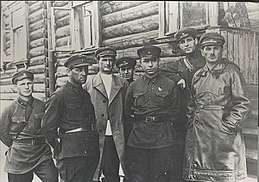
In response, Zemskov wrote that the charge that Zemskov allegedly did not compare new data with already known information could not be called fair. In his words, the trouble with most western writers is that they do not benefit from such comparisons. Zemskov added that when he tried not to overuse the juxtaposition of new information with "old" one, it was only because of a sense of delicacy, not to once again psychologically traumatise the researchers whose works used incorrect figures, as it turned out after the publication of the statistics by the OGPU-NKVD-MGB-MVD.[119]
According to French historian Nicolas Werth, the mountains of the materials of the Gulag archives, which are stored in funds of the State Archive of the Russian Federation and are being constantly exposed during the last fifteen years, represent only a very small part of bureaucratic prose of immense size left over the decades of "creativity" by the "dull and reptile" organisation managing the Gulag. In many cases, local camp archives, which had been stored in sheds, barracks, or other rapidly disintegrating buildings, simply disappeared in the same way as most of the camp buildings did.[125]
In 2004 and 2005, some archival documents were published in the edition Istoriya Stalinskogo Gulaga. Konets 1920-kh — Pervaya Polovina 1950-kh Godov. Sobranie Dokumentov v 7 Tomakh (The History of Stalin's Gulag. From the Late 1920s to the First Half of the 1950s. Collection of Documents in Seven Volumes), wherein each of its seven volumes covered a particular issue indicated in the title of the volume:
- Mass Repression in the USSR (Massovye Repressii v SSSR);[126]
- Punitive System. Structure and Cadres (Karatelnaya Sistema. Struktura i Kadry);[127]
- Economy of the Gulag (Ekonomika Gulaga);[128]
- The Population of the Gulag. The Number and Conditions of Confinement (Naselenie Gulaga. Chislennost i Usloviya Soderzhaniya);[129]
- Specsettlers in the USSR (Specpereselentsy v SSSR);[130]
- Uprisings, Riots, and Strikes of Prisoners (Vosstaniya, Bunty i Zabastovki Zaklyuchyonnykh);[131] and
- Soviet Repressive and Punitive Policy. Annotated Index of Cases of the SA RF (Sovetskaya Pepressivno-karatelnaya Politika i Penitentsiarnaya Sistema. Annotirovanniy Ukazatel Del GA RF).[132]
The edition contains the brief introductions by the two "patriarchs of the Gulag science", Robert Conquest and Aleksandr Solzhenitsyn, and 1431 documents, the overwhelming majority of which were obtained from funds of the State Archive of the Russian Federation.[133]
History of Gulag population estimates
During the decades before the dissolution of the USSR, the debates about the population size of GULAG failed to arrive at generally accepted figures; wide-ranging estimates have been offered,[134] and the bias toward higher or lower side was sometimes ascribed to political views of the particular author.[134] Some of those earlier estimates (both high and low) are shown in the table below.
| GULAG population | Year the estimate was made for | Source | Methodology | ||
| 15 million | 1940–42 | Mora & Zwiernag (1945)[135] | – | ||
| 2.3 million | December 1937 | Timasheff (1948)[136] | Calculation of disenfranchised population | ||
| Up to 3.5 million | 1941 | Jasny (1951)[137] | Analysis of the output of the Soviet enterprises run by NKVD | ||
| 50 million | total number of persons passed through GULAG | Solzhenitsyn (1975)[138] | Analysis of various indirect data, including own experience and testimonies of numerous witnesses | ||
| 17.6 million | 1942 | Anton Antonov-Ovseenko (1999)[139] | NKVD documents[140] | ||
| 4–5 million | 1939 | Wheatcroft (1981)[141] | Analysis of demographic data.a | ||
| 10.6 million | 1941 | Rosefielde (1981)[142] | Based on data of Mora & Zwiernak and annual mortality.a | ||
| 5.5–9.5 million | late 1938 | Conquest (1991)[143] | 1937 Census figures, arrest and deaths estimates, variety of personal and literary sources.a | ||
| 4–5 million | every single year | Volkogonov (1990s)[144] | |||
| a.^ Note: Later numbers from Rosefielde, Wheatcroft and Conquest were revised down by the authors themselves.[24][62] | |||||
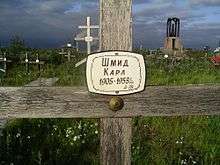
The glasnost political reforms in the late 1980s and the subsequent dissolution of the USSR led to the release of a large amount of formerly classified archival documents,[145] including new demographic and NKVD data.[95] Analysis of the official GULAG statistics by Western scholars immediately demonstrated that, despite their inconsistency, they do not support previously published higher estimates.[134] Importantly, the released documents made possible to clarify terminology used to describe different categories of forced labour population, because the use of the terms "forced labour", "GULAG", "camps" interchangeably by early researchers led to significant confusion and resulted in significant inconsistencies in the earlier estimates.[134] Archival studies revealed several components of the NKVD penal system in the Stalinist USSR: prisons, labor camps, labor colonies, as well as various "settlements" (exile) and of non-custodial forced labour.[5] Although most of them fit the definition of forced labour, only labour camps, and labour colonies were associated with punitive forced labour in detention.[5] Forced labour camps ("GULAG camps") were hard regime camps, whose inmates were serving more than three-year terms. As a rule, they were situated in remote parts of the USSR, and labour conditions were extremely hard there. They formed a core of the GULAG system. The inmates of "corrective labour colonies" served shorter terms; these colonies were located in less remote parts of the USSR, and they were run by local NKVD administration.[5] Preliminary analysis of the GULAG camps and colonies statistics (see the chart on the right) demonstrated that the population reached the maximum before the World War II, then dropped sharply, partially due to massive releases, partially due to wartime high mortality, and then was gradually increasing until the end of Stalin era, reaching the global maximum in 1953, when the combined population of GULAG camps and labour colonies amounted to 2,625,000.[146]
The results of these archival studies convinced many scholars, including Robert Conquest[24] or Stephen Wheatcroft to reconsider their earlier estimates of the size of the GULAG population, although the 'high numbers' of arrested and deaths are not radically different from earlier estimates.[24] Although such scholars as Rosefielde or Vishnevsky point at several inconsistencies in archival data with Rosefielde pointing out the archival figure of 1,196,369 for the population of the Gulag and labor colonies combined on December 31, 1936 is less than half the 2.75 million labor camp population given to the Census Board by the NKVD for the 1937 census,[147][123] it is generally believed that these data provide more reliable and detailed information that the indirect data and literary sources available for the scholars during the Cold War era.[95] Although Conquest cited Beria's report to the Politburo of the labor camp numbers at the end of 1938 stating there were almost 7 million prisoners in the labor camps, more than three times the archival figure for 1938 and an official report to Stalin by the Soviet minister of State Security in 1952 stating there were 12 million prisoners in the labor camps.[148]
These data allowed scholars to conclude that during the period of 1928–53, about 14 million prisoners passed through the system of GULAG labour camps and 4–5 million passed through the labour colonies.[24] Thus, these figures reflect the number of convicted persons, and do not take into account the fact that a significant part of Gulag inmates had been convicted more than one time, so the actual number of convicted is somewhat overstated by these statistics.[95] From other hand, during some periods of Gulag history the official figures of GULAG population reflected the camps' capacity, not the actual number of inmates, so the actual figures were 15% higher in, e.g. 1946.[24]
Impact
Culture
The Gulag spanned nearly four decades of Soviet and East European history and affected millions of individuals. Its cultural impact was enormous.
The Gulag has become a major influence on contemporary Russian thinking, and an important part of modern Russian folklore. Many songs by the authors-performers known as the bards, most notably Vladimir Vysotsky and Alexander Galich, neither of whom ever served time in the camps, describe life inside the Gulag and glorified the life of "Zeks". Words and phrases which originated in the labor camps became part of the Russian/Soviet vernacular in the 1960s and 1970s. The memoirs of Alexander Dolgun, Aleksandr Solzhenitsyn, Varlam Shalamov and Yevgenia Ginzburg, among others, became a symbol of defiance in Soviet society. These writings harshly chastised the Soviet people for their tolerance and apathy regarding the Gulag, but at the same time provided a testament to the courage and resolve of those who were imprisoned.
Another cultural phenomenon in the Soviet Union linked with the Gulag was the forced migration of many artists and other people of culture to Siberia. This resulted in a Renaissance of sorts in places like Magadan, where, for example, the quality of theatre production was comparable to Moscow's and Eddie Rosner played jazz.
Literature
Many eyewitness accounts of Gulag prisoners have been published:
- Varlam Shalamov's Kolyma Tales is a short-story collection, cited by most major works on the Gulag, and widely considered one of the main Soviet accounts.
- Victor Kravchenko wrote I Chose Freedom after defecting to the United States in 1944. As a leader of industrial plants he had encountered forced labour camps in across the Soviet Union from 1935 to 1941. He describes a visit to one camp at Kemerovo on the Tom River in Siberia. Factories paid a fixed sum to the KGB for every convict they employed.
- Anatoli Granovsky wrote I Was an NKVD Agent after defecting to Sweden in 1946 and included his experiences seeing gulag prisoners as a young boy, as well as his experiences as a prisoner himself in 1939. Granovsky's father was sent to the gulag in 1937.
- Julius Margolin's book A Travel to the Land Ze-Ka was finished in 1947, but it was impossible to publish such a book about the Soviet Union at the time, immediately after World War II.
- Gustaw Herling-Grudziński wrote A World Apart, which was translated into English by Andrzej Ciolkosz and published with an introduction by Bertrand Russell in 1951. By describing life in the gulag in a harrowing personal account, it provides an in-depth, original analysis of the nature of the Soviet communist system.
- Victor Herman's book Coming out of the Ice: An Unexpected Life. Herman experienced firsthand many places, prisons, and experiences that Aleksandr Solzhenitsyn was able to reference in only passing or through brief second hand accounts.
- Aleksandr Solzhenitsyn's book The Gulag Archipelago was not the first literary work about labour camps. His previous book on the subject, "One Day in the Life of Ivan Denisovich", about a typical day in the life of a Gulag inmate, was originally published in the most prestigious Soviet monthly, Novy Mir (New World), in November 1962, but was soon banned and withdrawn from all libraries. It was the first work to demonstrate the Gulag as an instrument of governmental repression against its own citizens on a massive scale. The First Circle, an account of three days in the lives of prisoners in the Marfino sharashka or special prison was submitted for publication to the Soviet authorities shortly after One Day in the Life of Ivan Denisovich but was rejected and later published abroad in 1968.
- Slavomir Rawicz's book "The Long Walk: The True Story of a Trek to Freedom": In 1941, the author and six other fellow prisoners escaped a Soviet labour camp in Yakutsk—a camp where enduring hunger, cold, untended wounds, untreated illnesses, and avoiding daily executions were everyday horrors.
- János Rózsás, a Hungarian writer, often referred to as the Hungarian Solzhenitsyn,[149] wrote many books and articles on the issue of the Gulag.
- Zoltan Szalkai, a Hungarian documentary filmmaker, made several films about gulag camps.
- Karlo Štajner, a Croatian communist who was active in the former Kingdom of Yugoslavia and the manager of the Comintern Publishing House in Moscow 1932–39, was arrested one night and taken from his Moscow home after being accused of anti-revolutionary activities. He spent the next 20 years in camps from Solovki to Norilsk. After USSR–Yugoslavian political normalization he was re-tried and quickly found innocent. He left the Soviet Union with his wife, who had been waiting for him for 20 years, in 1956 and spent the rest of his life in Zagreb, Croatia. He wrote an impressive book titled 7000 days in Siberia.
- Dancing Under the Red Star by Karl Tobien (ISBN 1-4000-7078-3) tells the story of Margaret Werner, an athletic girl who moves to Russia right before the start of Stalin's terror. She faces many hardships, as her father is taken away from her and imprisoned. Werner is the only American woman who survived the Gulag to tell about it.
- Alexander Dolgun's Story: An American in the Gulag (ISBN 0-394-49497-0), by a member of the US Embassy, and I Was a Slave in Russia (ISBN 0-8159-5800-5), an American factory owner's son, were two more American citizens interned who wrote of their ordeal. They were interned due to their American citizenship for about eight years c. 1946–55.
- Yevgenia Ginzburg wrote two famous books about her remembrances, Journey Into the Whirlwind and Within the Whirlwind.
- Savić Marković Štedimlija, a pro-Croatian Montenegrin ideologist. Caught in Austria by the Red Army in 1945, he was sent to the USSR and spent ten years in the Gulag. After his release, Marković wrote his autobiographical account in two volumes titled Ten years in Gulag (Deset godina u Gulagu, Matica crnogorska, Podgorica, Montenegro 2004).
- Anița Nandriș-Cudla's book, 20 Years in Siberia [20 de ani în Siberia] is the own life's account written by a Romanian peasant woman from Bucovina (Mahala village near Cernăuți) who managed to survive the harsh, forced labour system together with her three sons. Together with her husband and her three underage children, she was deported from Mahala village to the Soviet Yamalo-Nenets Autonomous Okrug, at the Polar Circle, without a trial or even a communicated accusation. The same night of June 12 to 13, 1941, (that is before the breakout of the Second World War), overall 602 fellow villagers were arrested and deported, without any prior notice. Her mother received the same sentence but was spared from deportation after the fact that she was a paraplegic was acknowledged by the authorities. It was later discovered that the reason for her deportation and forced labour was the fake and nonsensical claim that, allegedly, her husband had been a mayor in the Romanian administration, a politician and a rich peasant, none of the latter of which was true. Separated from her husband, she brought up the three boys, overcame typhus, scorbutus, malnutrition, extreme cold and harsh toils, to later return to Bucovina after rehabilitation. Her manuscript was written toward the end of her life, in the simple and direct language of a peasant with three years of public school education, and was secretly brought to Romania before the fall of Romanian communism, in 1982. Her manuscript was first published in 1991. Her deportation was shared mainly with Romanians from Bucovina and Basarabia, Finnish and Polish prisoners, as token proof to show that Gulag labour camps had also been used for the shattering/ extermination of the natives in the newly occupied territories of the Soviet Union.
- Frantsishak Alyakhnovich – Solovki prisoner
- Blagoy Popov, a Bulgarian communist and a defendant in the Leipzig trial, along with Georgi Dimitrov and Vasil Tanev, was arrested in 1937 during the Stalinist purges and spent seventeen years in Norillag. Popov was released in 1954, after the death of Stalin, and returned to Bulgaria.[150] He wrote his autobiographical account in the book From the Leipzig trial to the Siberia camps (От Лайпцигския процес в Сибирските лагери, Изток-Запад, София, България, 2012 ISBN 978-619-152-025-1).
- Mkrtich Armen, an Armenian writer who was imprisoned in 1937 and rehabilitated in 1945, published a collection of his memories under the title "They Ordered to Give You" in 1964.
- Gurgen Mahari, an Armenian writer and poet, who was arrested in 1936, released in 1947, arrested again in 1948 and sent into Siberian exile as an "unreliable type" until 1954, wrote "Barbed Wires in Blossom", a novella based largely on his personal experiences in a Soviet gulag.
- Gulag Boss: A Soviet Memoir is a 2011 memoir by Fyodor Vasilevich Mochulsky (1918–1999), a Soviet Engineer and eventual head of numerous Gulag camps in the northern Russian region of Pechorlag, Pechora, from 1940 to 1946.
Colonisation
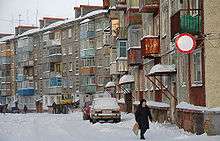
Soviet state documents show that the goals of the gulag included colonisation of sparsely populated remote areas. To this end, the notion of "free settlement" was introduced.
When well-behaved persons had served the majority of their terms, they could be released for "free settlement" (вольное поселение, volnoye poseleniye) outside the confinement of the camp. They were known as "free settlers" (вольнопоселенцы, volnoposelentsy; not to be confused with the term ссыльнопоселенцы, ssyl'noposelentsy, "exile settlers"). In addition, for persons who served full term, but who were denied the free choice of place of residence, it was recommended to assign them for "free settlement" and give them land in the general vicinity of the place of confinement.
The gulag inherited this approach from the katorga system.
It is estimated that of the 40,000 people collecting state pensions in Vorkuta, 32,000 are trapped former gulag inmates, or their descendants.[151]
Life after a term was served
Persons who served a term in a camp or prison were restricted from taking a wide range of jobs. Concealment of a previous imprisonment was a triable offence. Persons who served terms as "politicals" were nuisances for "First Departments" (Первый Отдел, Pervyj Otdel), outlets of the secret police at all enterprises and institutions), because former "politicals" had to be monitored.
Many people who were released from camps were restricted from settling in larger cities.
Memorialization
Gulag memorials
_-_59.jpg)
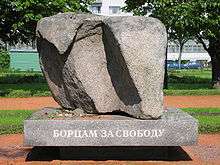
Both Moscow and St. Petersburg have memorials to the victims of the Gulag made of boulders from the Solovki camp — the first prison camp in the Gulag system. Moscow's memorial is on Lubyanka Square, the site of the headquarters of the NKVD. People gather at these memorials every year on the Day of Victims of the Repression (October 30).
Gulag Museum
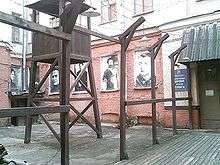
Moscow has the State Gulag Museum whose first director was Anton Antonov-Ovseyenko.[152][153][154][155] In 2015, another museum dedicated to the Gulag was opened in Moscow.[156]
See also
- Corrective labour colony
- List of Gulag camps
- MVD special camp
- List of concentration and internment camps
- 101st kilometre
- Article 58 (RSFSR Penal Code)
- Federal Prisons System of the Russian Federation
- Gulag detainees
- Forced settlements in the Soviet Union
- Mass graves in the Soviet Union
- Memorial Society
- Persecution of Christians in the Soviet Union
- Political abuse of psychiatry in the Soviet Union
- Political repression in the Soviet Union
- Population transfer in the Soviet Union
- Sharashka, a form of Soviet OKB within the Gulag system of camps
- USSR anti-religious campaign (1917–1921)
- USSR anti-religious campaign (1921–1928)
- USSR anti-religious campaign (1928–1941)
- USSR anti-religious campaign (1958–1964)
- USSR anti-religious campaign (1970s–1990)
- Concentration camps in the Independent State of Croatia
- Francoist concentration camps – Francoist Spain
- Internment camps in Sweden during World War II
- Penal labor in the United States
- Danube–Black Sea Canal
- Devil's Island – French Guiana
- Goli otok – Yugoslavia
- Katorga – a system of penal labour that existed in both the Russian Empire and the Soviet Union
- Xinjiang reeducation camps – Xinjiang, China
- Nazi concentration camps
- Kwalliso – North Korea
- Laogai – China
- Military Units to Aid Production – Cuba
- Pitestti Prison - Socialist Republic of Romania
- Reeducation camp – Vietnam
- Re-education through labor - China
- Spaç Prison – People's Socialist Republic of Albania
Notes
- Based on data from Memorial, a human-rights group.
- Some disputed[2] estimates range from over 2.7[6] to 6[7][8][9] million[2]
- /ˈɡuːlɑːɡ/, UK also /-læɡ/; Russian: ГУЛаг, romanized: GULag, [ɡʊˈlak] (

- The original name given to the system of camps which was controlled by the GPU was the Main Administration of Corrective Labor Camps and Labor Settlements (Russian: Главное Управление Исправительно-Трудовых Лагерей, Glavnoye Upravleniye Ispravitelno-Trudovykh Lagerey).
- Including those who died in custody.
- Special contingent.
References
- Memorial http://www.memo.ru/history/NKVD/GULAG/r1/r1-4.htm
- Healey, Dan (June 1, 2018). "GOLFO ALEXOPOULOS. Illness and Inhumanity in Stalin's Gulag". The American Historical Review. 123 (3): 1049–1051. doi:10.1093/ahr/123.3.1049.
New studies using declassified Gulag archives have provisionally established a consensus on mortality and "inhumanity." The tentative consensus says that once secret records of the Gulag administration in Moscow show a lower death toll than expected from memoir sources, generally between 1.5 and 1.7 million (out of 18 million who passed through) for the years from 1930 to 1953.
- Wheatcroft, Stephen G. (1999). "Victims of Stalinism and the Soviet Secret Police: The Comparability and Reliability of the Archival Data. Not the Last Word" (PDF). Europe-Asia Studies. 51 (2): 320. doi:10.1080/09668139999056.
- Rosefielde, Steven. 2009. Red Holocaust. Routledge. ISBN 0-415-77757-7. p. 67 "...more complete archival data increases camp deaths by 19.4 percent to 1,258,537"; pg 77: "The best archivally-based estimate of Gulag excess deaths at present is 1.6 million from 1929 to 1953."
- Getty, Arch; Rittersporn, Gábor; Zemskov, Viktor (October 1993). "Victims of the Soviet penal system in the pre-war years: a first approach on the basis of archival evidence" (PDF). American Historical Review. 98 (4): 1017–1049. doi:10.2307/2166597. JSTOR 2166597.
- Pohl, The Stalinist Penal System, p. 131.
- Alexopoulos, Golfo (2017). Illness and Inhumanity in Stalin's Gulag. Yale University Press. ISBN 978-0-300-17941-5.
- Figes, Orlando (2009). "Ученый: при Сталине погибло больше, чем в холокост". BBC News.
Хотя даже по самым консервативным оценкам, от 20 до 25 млн человек стали жертвами репрессий, из которых, возможно, от пяти до шести миллионов погибли в результате пребывания в ГУЛАГе. Translation: The most conservative calculations speak of 20-25 million victims of repression, 5 to 6 million of whom died in the gulag
- Erlikman, Vadim (2004). Poteri narodonaseleniia v XX veke: spravochnik. Moscow 2004: Russkaia panorama. ISBN 5-93165-107-1.
- Applebaum, Anne. Gulag: A History. Doubleday, 2003, pp. 50.
- "Introduction: Stalin’s Gulag." GULAG: Soviet Labor Camps and the Struggle for Freedom. US: Center for History and New Media, George Mason University. Retrieved 23 June 2020.
- "Gulag." History.com. A&E Networks. 2018. Retrieved 23 June 2020.
- Applebaum, Anne. Gulag: A History. Doubleday, 2003, pp. 50.
- Applebaum, Anne. 2017. "Gulag: An Introduction." Victims of Communism. Archived from the original on September 5, 2017.
- Remnick, David (April 14, 2003). "Seasons in Hell". The New Yorker. Retrieved March 27, 2017.
- Other Soviet penal-labor systems not formally included in the GULag were: (a) camps for prisoners of war captured by the Soviet Union, administered by GUPVI; (b) filtration camps set up during World War II for the temporary detention of Soviet Ostarbeiters and prisoners of war while the security organs screened them in order to "filter out" the black sheep; (c) "special settlements" for internal exiles including "kulaks" and deported ethnic minorities, such as Volga Germans, Poles, Balts, Caucasians, Crimean Tartars, and others. During certain periods of Soviet history, each of these camp systems held millions of people. Many hundreds of thousands were also sentenced to forced labour without imprisonment at their normal places of work. (Applebaum, pp. 579–80).
- Werth, Nicolas (January 20, 2009). "STATE VIOLENCE IN STALIN's REGIME : OUTLINE FOR AN INVENTORY AND CLASSIFICATION" (PDF). Stanford University.
- G. Zheleznov, Vinogradov, F. Belinskii (December 14, 1926). "Letter To the Presidium of the Central Executive Committee of the All-Union Communist Party (Bolshevik)". Retrieved April 15, 2015.CS1 maint: multiple names: authors list (link)
- Документ № 103. Справка о смертности заключённых в системе ГУЛага за период 1930—1956 гг. Mezhdunarodnyi Fond "Demokratiia". 2000. ISBN 5-85646-046-4.
- Смирнов, М.Б. (1998). Система Исправительно-трудовьх лагерей в СССР. Moscow: Звенья. ISBN 5-7870-0022-6.
- "Slave labour and criminal cultures". The Economist. October 19, 2013.
- Applebaum, Anne (2003) Gulag: A History. Doubleday. ISBN 0-7679-0056-1
- "Gulag: a History of the Soviet Camps". Arlindo-correia.org. Retrieved January 6, 2009.
- Conquest, Robert. 1997. "Victims of Stalinism: A Comment Archived September 27, 2011, at the Wayback Machine." Europe-Asia Studies 49(7):1317–19. "We are all inclined to accept the Zemskov totals (even if not as complete) with their 14 million intake to Gulag 'camps' alone, to which must be added 4–5 million going to Gulag 'colonies', to say nothing of the 3.5 million already in, or sent to, 'labour settlements'. However taken, these are surely 'high' figures." There are reservations to be made. For example, we now learn that the Gulag reported totals were of capacity rather than actual counts,leading to an underestimate in 1946 of around 15%. Then as to the numbers 'freed': there is no reason to accept the category simply because the MVD so listed them, and, in fact, we are told of 1947 (when the anecdotal evidence is of almost no one released) that this category concealed deaths: 100000 in the first quarter of the year'"
- J. Gheith,K. Jolluck (2011). Gulag Voices: Oral Histories of Soviet Incarceration and Exile. Palgrave Macmillan US. pp. 3. ISBN 978-0-230-61062-0.
Orlando Figes Estimates that 25 million people circulated through the Gulag system between 1928 and 1953
- "Repressions". Publicist.n1.by. Retrieved January 6, 2009.
- "H-Net Reviews". Archived from the original on June 27, 2007. Retrieved December 27, 2014.
- Репрессии против поляков и польских граждан Archived December 13, 2014, at the Wayback Machine
- MVD of Russia: An Encyclopedia (МВД России: энциклопедия), 2002, ISBN 5-224-03722-0, p.541
- "Repressions". Publicist.n1.by. Archived from the original on March 27, 2008. Retrieved January 6, 2009.
- "What Were Their Crimes?". Gulaghistory.org. Retrieved January 6, 2009.
- Uschan, M. Political Leaders. Lucent Books. 2002.
- "Repressions". Publicist.n1.by. Archived from the original on March 11, 2008. Retrieved January 6, 2009.
- News Release: Forced labor camp artifacts from Soviet era on display at NWTC Archived August 28, 2008, at the Wayback Machine
- Anne Applebaum. "GULAG: a history". Archived from the original on October 13, 2007. Retrieved December 21, 2007.
- "The Hidden Gulag – Exposing North Korea's Prison Camps" (PDF). The Committee for Human Rights in North Korea. Retrieved September 20, 2012.
- Antony Barnett (February 1, 2004). "Revealed: the gas chamber horror of North Korea's gulag". Guardian Unlimited. London. Retrieved December 21, 2007.
- Applebaum, Anne. Gulag: A History. Anchor, 2004, pp. xxxi
- Jakobson, Michael. Origins of the Gulag. E-book, The University Press of Kentucky, 2015, pp. 11
- Applebaum, Anne. Gulag: A History. Anchor, 2004, pp. xxix-xxx
- Applebaum, Anne. Gulag: A History. Anchor, 2004, pp. xxxiii
- Земсков, Виктор (1991). "ГУЛАГ (историко-социологический аспект)". Социологические исследования (№ 6, 7). Retrieved August 14, 2011.
- Applebaum, Anne. "Gulag: A History." Anchor, 2003, pp. 12
- =Applebaum, Anne. "Gulag: A History." Anchor, 2003, pp. 5
- Applebaum, "Gulag: A History", Chapter 3
- "The only way to attract the labor power necessary for our economic problems is to introduce compulsory labour service", in: Trotsky, Leon. "Leon Trotsky: Terrorism and Communism (Chapter 8)". www.marxists.org. Retrieved August 6, 2015.
- Jakobson, Michael. Origins of the Gulag. E-book, The University Press of Kentucky, pp. 52
- Applebaum, Anne. Gulag: A History. Anchor, 2004, pp. 12.
- Applebaum, Anne. Gulag: A History. Anchor, 2003, pp. 50.
- D.J. Dallin and B.I. Nicolayesky, Forced Labour in Soviet Russia, London 1948, p. 153.
- Applebaum, Anne (2004). Gulag: a History of the Soviet Camps. London: Penguin Books., p. 52-53
- Ellman, Michael (2002). "Soviet Repression Statistics: Some Comments" (PDF). Europe-Asia Studies. 54 (2): 1151–1172. doi:10.1080/0966813022000017177. Retrieved August 14, 2011.
- See, e.g. Jakobson, Michael. 1993. Origins of the GULag: The Soviet Prison Camp System 1917–34. Lexington, KY: University Press of Kentucky. p. 88.
- See, e.g. Ivanova, Galina M. 2000. Labor Camp Socialism: The Gulag in the Totalitarian System. Armonk, NY: M. E. Sharpe. ch. 2.
- See, for example, Gulaga, Naselenie. 2004. " sobranie dokumentov v 7 tomakh." Istorija stalinskogo Gulaga: konec 1920-kh – pervaia polovina 1950-kh godov, vol. 4, edited by V. P. Kozlov et al. Moskva: ROSSPEN.
- Applebaum, Anne (August 2, 2012). "The Camps Expand". Gulag: A History of the Soviet Camps. Penguin Books Limited. ISBN 9780141975269.
- "Таблица 3. Движение лагерного населения ГУЛАГа".
- Khlevniuk, Oleg (2004). The History of the Gulag. New Haven: Yale University Press. p. 9.
- khlevniuk, Oleg (2004). The History of the Gulag. New Haven: Yale University Press. p. 11.
- Khlevniuk, Oleg (2004). The History of the Gulag. New Haven: Yale University Press. p. 17.
- Rosefielde, Steven (February 12, 2007). The Russian economy: from Lenin to Putin. ISBN 9781405113373.
- Applebaum, Anne (2003). Gulag: a history. ISBN 9780767900560.
- Franciszek Proch, Poland's Way of the Cross, New York 1987 P.146
- "Project In Posterum". Project In Posterum. Retrieved December 19, 2011.
- Encyklopedia PWN 'KAMPANIA WRZEŚNIOWA 1939' Archived September 27, 2005, at the Wayback Machine, last retrieved on December 10, 2005, Polish language
- Marek Jan Chodakiewicz (2004). Between Nazis and Soviets: Occupation Politics in Poland, 1939–1947. Lexington Books. ISBN 978-0-7391-0484-2.
- beanbean (May 2, 2008). "A Polish life. 5: Starobielsk and the trans-Siberian railway". My Telegraph. London. Archived from the original on May 31, 2014. Retrieved May 8, 2012.
- Hope, Michael. "Polish deportees in the Soviet Union". Wajszczuk.v.pl. Archived from the original on April 8, 2009. Retrieved January 6, 2009.
- GULAG: a History, Anne Applebaum
- Zemskov, Gulag, Sociologičeskije issledovanija, 1991, No. 6, pp. 14–15.
- "Repressions". Publicist.n1.by. Archived from the original on April 19, 2009. Retrieved January 6, 2009.
- Ivanova, Galina Mikhailovna (2000). Labor Camp Socialism: The Gulag in the Soviet Totalitarian System. Armonk, NY: Sharpe. pp. 69–126.
- Khevniuk, Oleg V. (2004). The History of the Gulag: From Collectivization to the Great Terror. Yale University Press. pp. 236–286.
- Bacon, Edwin (1994). The Gulag at War: Stalin's Forced Labour System in the Light of the Archives. New York, NY: New York University Press. pp. 42–63, 82–100, 123–144.
- Mark Elliott. "The United States and Forced Repatriation of Soviet Citizens, 1944–47," Political Science Quarterly, Vol. 88, No. 2 (June 1973), pp. 253–275.
- "Repatriation – The Dark Side of World War II". Fff.org. Archived from the original on January 17, 2012. Retrieved January 6, 2009.
- "Forced Repatriation to the Soviet Union: The Secret Betrayal". Hillsdale.edu. September 1, 1939. Archived from the original on February 7, 2012. Retrieved January 6, 2009.
- "The warlords: Joseph Stalin". Channel4.com. March 6, 1953. Retrieved January 6, 2009.
- "Remembrance (Zeithain Memorial Grove)". Stsg.de. August 16, 1941. Archived from the original on February 27, 2008. Retrieved January 6, 2009.
- "Soviet Prisoners of War: Forgotten Nazi Victims of World War II". Historynet.com. September 8, 1941. Archived from the original on March 30, 2008. Retrieved January 6, 2009.
- "Sorting Pieces of the Russian Past". Hoover.org. October 23, 2002. Archived from the original on February 18, 2009. Retrieved January 6, 2009.
- "Patriots ignore greatest brutality". Smh.com.au. August 13, 2007. Retrieved January 6, 2009.
- "Joseph Stalin killer file". Moreorless.au.com. May 23, 2001. Archived from the original on August 3, 2013. Retrieved January 6, 2009.
- Земсков В.Н. К вопросу о репатриации советских граждан. 1944–1951 годы // История СССР. 1990. № 4 Zemskov V.N. On repatriation of Soviet citizens. Istoriya SSSR., 1990, No.4
- ("Военно-исторический журнал" ("Military-Historical Magazine"), 1997, №5. page 32)
- Germans Find Mass Graves at an Ex-Soviet Camp New York Times, September 24, 1992
- Ex-Death Camp Tells Story Of Nazi and Soviet Horrors New York Times, December 17, 2001
- "The museum of history of political repressions "Perm-36"".
- "Gulag revisited: Barbed memories". Russia Today. 2012.
- "Сюжеты о "Перми-36" на НТВ сочли "квазижурналистским пасквилем"". February 13, 2015. Retrieved August 31, 2015.
- Getty, J. A.; Rittersporn, G. T.; Zemskov, V. N. (1993). "Victims of the Soviet Penal System in the Pre-war Years". American Historical Review. 98 (4): 1017–1049. doi:10.2307/2166597. JSTOR 2166597. Archived from the original on 11 June 2008.
The long-awaited archival evidence on repression in the period of the Great Purges shows that levels of arrests, political prisoners, executions, and general camp populations tend to confirm the orders of magnitude indicated by those labeled as "revisionists" and mocked by those proposing high estimates.
- Wheatcroft, Stephen G. (1999). "Victims of Stalinism and the Soviet Secret Police: The Comparability and Reliability of the Archival Data. Not the Last Word" (PDF). Europe-Asia Studies. 51 (2): 340–342. doi:10.1080/09668139999056.
For decades, many historians counted Stalin' s victims in 'tens of millions', which was a figure supported by Solzhenitsyn. Since the collapse of the USSR, the lower estimates of the scale of the camps have been vindicated. The arguments about excess mortality are far more complex than normally believed. R. Conquest, The Great Terror: A Re-assessment (London, 1992) does not really get to grips with the new data and continues to present an exaggerated picture of the repression. The view of the `revisionists' has been largely substantiated (J. Arch Getty & R. T. Manning (eds), Stalinist Terror: New Perspectives (Cambridge, 1993)). The popular press, even TLS and The Independent, have contained erroneous journalistic articles that should not be cited in respectable academic articles.
- Michael Ellman. Soviet Repression Statistics: Some Comments. Europe-Asia Studies, Vol. 54, No. 7 (Nov. 2002), pp. 1151–1172
- Applebaum, Anne (2003) Gulag: A History. Doubleday. ISBN 0-7679-0056-1 pg 583: "both archives and memoirs indicate that it was common practice in many camps to release prisoners who were on the point of dying, thereby lowering camp death statistics."
- "Demographic Losses Due to Repressions", by Anatoly Vishnevsky, Director of the Centre for Human Demography and Ecology, Russian Academy of Sciences, (in Russian)
- "The History of the GULAG" Archived June 22, 2010, at the Wayback Machine, by Oleg V. Khlevniuk
- Golfo Alexopoulos, https://web.archive.org/web/20190429041657/https://www.youtube.com/watch?v=TwUgqHthjTs. "Medicine and Mortality in the Gulag". NYUJordanCenter.
- Hardy, Jeffery. "Slavic Review, Volume 77, Issue 1 Spring 2018 pp.269-270". Cambridge Core. © Association for Slavic, East European, and Eurasian Studies 2018. Archived from the original on April 29, 2019. Retrieved July 29, 2019.
- History of Gulag in 7 Volumes. Volume 2: Structure and Personnel documents, ed. Petrov N. V. State Archive of the Russian Federation, 2004 (in Russian)
- The Heads of the Central Committee of NKVD Petrov N. V., Sorokyn K. V. Who Headed NKVD 1934—1941 Moscow: Memorial, 1999, 504 pages. ISBN 5-7870-0032-3
- Lubyanka. VCheka — KGB. Documents 1917–1960 Moscow: International Democracy Fund, 1997. ISBN 5-89511-004-5
- The Gulag Collection: Paintings of Nikolai Getman Archived November 27, 2007, at the Wayback Machine
- Brent, Jonathan. 2008. "Introduction." Pp. 1–18 in Inside the Stalin Archives: Discovering the New Russia. Atlas & Co. ISBN 0-9777433-3-0. Archived from the original on February 24, 2009. p. 12.
- Borodkin, Leonid, and Simon Ertz. 2005. "Forced Labor and the Need for Motivation: Wages and Bonuses in the Stalinist Camp System." Comparative Economic Studies 47(2):418–36.
- Khlevniuk, Oleg (2004). The History of the Gulag. New Haven: Yale University Press. p. 55.
- Gorlizki, Yoram (June 28, 2001). "Theft Under Stalin: A Property Rights Analysis" (PDF). Retrieved March 7, 2017.
- Khlevniuk, Oleg (2004). The History of the Gulag. New Haven: Yale University Press. p. 61.
- "Nikolai Getman: The Gulag Collection Archived May 13, 2012, at the Wayback Machine"
- Yedlin, Tova (1999). Maxim Gorky: A Political Biography. Greenwood Publishing Group. p. 188. ISBN 978-0-275-96605-8.
- Map of Gulag, made by the Memorial Foundation on: .
- "Система исправительно-трудовых лагерей в СССР". Memo.ru. Retrieved January 6, 2009.
- Ivanova, Galina; Flath, Carol; Raleigh, Donald (2000). Labor Camp Socialism: The Gulag in the Soviet Totalitarian System. London: M.E. Sharpe. p. 188. ISBN 978-0-7656-0426-2.
- Anne Applebaum — Inside the Gulag Archived October 15, 2008, at the Wayback Machine
- "Coercion versus Motivation: Forced Labor in Norilsk" (PDF). Retrieved January 6, 2009.
- Barnes, Stephen A. (2011). Death and Redemption: The Gulag and the Shaping of Soviet Society. Princeton: Princeton University Press. pp. 7–16. ISBN 978-0-691-15112-0.
- Arendt, Hannah. 1985. The Origins of Totalitarianism. Harcourt.
- Земсков, Виктор (1995). "К вопросу о масштабах репрессий в СССР". Социологические исследования (№ 9): 118–127. Retrieved August 20, 2011.
- Лопатников, Леонид (2009). "К дискуссиям о статистике "Большого террора"". Вестник Европы (№ 26–27). Retrieved August 20, 2011.
- Земсков, Виктор (1994). "Политические репрессии в СССР (1917–1990 гг.)" (PDF). Россия XXI (№ 1–2): 107–124. Archived from the original (PDF) on March 30, 2012. Retrieved August 17, 2011.
- Rousso, Henry; Golsan, Richard (2004). Stalinism and nazism: history and memory compared. U of Nebraska Press. p. 92. ISBN 978-0-8032-9000-6.
- Vishnevsky, Alantoly. Демографические потери от репрессий (The Demographic Loss of Repression), Demoscope Weekly, December 31, 2007, retrieved April 13, 2011
- Максудов, Сергей (1995). "О публикациях в журнале "Социс"". Социологические исследования (№ 9): 114–118. Retrieved August 17, 2011.
- Werth, Nicolas (June 2007). "Der Gulag im Prisma der Archive. Zugänge, Erkenntnisse, Ergebnisse" (PDF). Osteuropa. 57 (6): 9–30. Archived from the original (PDF) on January 9, 2014.
- История сталинского Гулага. Конец 1920–х — первая половина 1950–х годов. Собрание документов в 7 томах. Том 1. Массовые репрессии в СССР. Москва: Российская политическая энциклопедия. 2004. ISBN 978-5-8243-0605-7.
- История сталинского Гулага. Конец 1920-х — первая половина 1950-х годов. Собрание документов в 7 томах. Том 2. Карательная система. Структура и кадры. Москва: Российская политическая энциклопедия. 2004. ISBN 978-5-8243-0606-4.
- История сталинского Гулага. Конец 1920-х — первая половина 1950-х годов. Собрание документов в 7 томах. Том 3. Экономика Гулага. Москва: Российская политическая энциклопедия. 2004. ISBN 978-5-8243-0607-1.
- История сталинского Гулага. Конец 1920-х — первая половина 1950–х годов. Собрание документов в 7 томах. Том 4. Население Гулага. Численность и условия содержания. Москва: Российская политическая энциклопедия. 2004. ISBN 978-5-8243-0608-8.
- История сталинского Гулага. Конец 1920-х — первая половина 1950-х годов. Собрание документов в 7 томах. Том 5. Спецпереселенцы в СССР. Москва: Российская политическая энциклопедия. 2004. ISBN 978-5-8243-0608-8.
- История сталинского Гулага. Конец 1920-х — первая половина 1950-х годов. Собрание документов в 7 томах. Том 6. Восстания, бунты и забастовки заключенных. Москва: Российская политическая энциклопедия. 2004. ISBN 978-5-8243-0610-1.
- История сталинского Гулага. Конец 1920–х — первая половина 1950–х годов. Собрание документов в 7 томах. Том 7. Советская репрессивно-карательная политика и пенитенциарная система. Аннотированный указатель дел ГА РФ. Москва: Российская политическая энциклопедия. 2005. ISBN 978-5-8243-0611-8.
- Полян, Павел (2006). "Новые карты архипелага ГУЛАГ". Неприкосновенный запас (№2 (46)): 277–286. Retrieved August 20, 2011.
- Edwin Bacon. Glasnost' and the Gulag: New Information on Soviet Forced Labour around World War II. Soviet Studies, Vol. 44, No. 6 (1992), pp. 1069–1086
- Cited in David Dallin and Boris Nicolaevsky, Forced Labor in Soviet Russia. (New Haven: Yale University Press, 1947), p. 59-62.
- N. S. Timasheff. The Postwar Population of the Soviet Union. American Journal of Sociology, Vol. 54, No. 2 (Sep. 1948), pp. 148–155
- Naum Jasny. Labor and Output in Soviet Concentration Camps. Journal of Political Economy, Vol. 59, No. 5 (Oct. 1951), pp. 405–419
- Solzhenitsyn, A. The Gulag Archipelago Two, Harper and Row, 1975. Estimate was through 1953.
- (in Russian) Beria Moscow, ACT, 1999, ISBN 5-237-03178-1, page 203.
- According to Anton Antonov-Ovseenko, "average number of prisoners [in Gulag] was 17.6 million in 1942, which many times exceeds the "declassified" official (forged) data frequently published in press"; the number was taken from an NKVD document dated January 18, 1945. The number of prisoners in 1943 was estimated as 13 million.
- S. G. Wheatcroft. On Assessing the Size of Forced Concentration Camp Labour in the Soviet Union, 1929–56. Soviet Studies, Vol. 33, No. 2 (Apr. 1981), pp. 265–295
- Steven Rosefielde. An Assessment of the Sources and Uses of Gulag Forced Labour 1929–56. Soviet Studies, Vol. 33, No. 1 (Jan. 1981), pp. 51–87
- Robert Conquest. Excess Deaths and Camp Numbers: Some Comments. Soviet Studies, Vol. 43, No. 5 (1991), pp. 949–952
- Rappaport, H. Joseph Stalin: A Biographical Companion. ABC-CLIO Greenwood. 1999.
- Andrea Graziosi. The New Soviet Archival Sources. Hypotheses for a Critical Assessment. Cahiers du Monde russe, Vol. 40, No. 1/2, Archives et nouvelles sources de l'histoiresoviétique, une réévaluation / Assessing the New Soviet Archival Sources (Jan. – Jun. 1999),pp. 13–63
- "The Total Number of Repressed", by Anatoly Vishnevsky, Director of the Center for Human Demography and Ecology, Russian Academy of Sciences, (in Russian)
- http://www.paulbogdanor.com/left/soviet/rosefielde.pdf
- https://www.bu.edu/iscip/pubseries/PubSeries1conquest.pdf
- One Day in the Life of Ivan Denisovich.
- Попов, Благой (2012). От Лайпцигския процес в Сибирските лагери. София: Издателство "Изток-Запад". pp. 37, 57. ISBN 978-619-152-025-1.
- Robert Conquest, Paul Hollander: Political violence: belief, behavior, and legitimation p.55, Palgrave Macmillan;(2008) ISBN 978-0-230-60646-3
- Гальперович, Данила (June 27, 2010). "Директор Государственного музея ГУЛАГа Антон Владимирович Антонов-Овсеенко". Radio Liberty. Retrieved August 19, 2011.
- Banerji, Arup (2008). Writing history in the Soviet Union: making the past work. Berghahn Books. p. 271. ISBN 978-81-87358-37-4.
- "About State Gulag Museum". The State Gulag Museum. Archived from the original on June 25, 2018. Retrieved August 19, 2011.
- "Gulag – Museum on Communism".
- "New Russian Gulag museum recreates Soviet terror". BBC. October 30, 2015.
Further reading
- Applebaum, Anne. 2003. Gulag: A History. Broadway Books. hardcover, 720 pp., ISBN 0-7679-0056-1.
- Ciszek, Walter. 1997. With God in Russia. Ignatius Press. 433 pp., ISBN 0-89870-574-6.
- Ertz, Simon. 2006. Zwangsarbeit im stalinistischen Lagersystem: Eine Untersuchung der Methoden, Strategien und Ziele ihrer Ausnutzung am Beispiel Norilsk, 1935–1953. Duncker & Humblot. 273 pp., ISBN 978-3-428-11863-2.
- Figes, Orlando. 2007. The Whisperers: Private Life in Stalin's Russia. Allen Lane. hardcover, 740 pp., ISBN 0-14-101351-6.
- Getty, J. Arch, and Oleg V. Naumov. 1999. The Road to Terror: Stalin and the Self-Destruction of the Bolsheviks, 1932–1939. New Haven, CT: Yale University Press. 635 pp., ISBN 0-300-07772-6.
- Gheith, Jehanne M., and Katherine R. Jolluck. 2010. Gulag Voices: Oral Histories of Soviet Detention and Exile, (Palgrave Studies in Oral History). Palgrave Macmillan. ISBN 0-230-61063-3
- Rawicz, Slawomir. 1995. The Long Walk. ISBN 1-55821-684-7
- Gregory, Paul R., and Valery Lazarev, eds. 2003. The Economics of Forced Labor: The Soviet Gulag. Stanford: Hoover Institution Press. ISBN 0-8179-3942-3.
- Herling-Grudzinski, Gustaw. 1996. A World Apart: Imprisonment in a Soviet Labor Camp During World War II. Penguin. 284 pp., ISBN 0-14-025184-7.
- Hochschild, Adam. 2003. The Unquiet Ghost: Russians Remember Stalin. Boston: Houghton Mifflin. 304 pp., paperback: ISBN 0-618-25747-0.
- Khlevniuk, Oleg V. 2004. The History of the Gulag: From Collectivization to the Great Terror. New Haven, CT: Yale University Press. hardcover, 464 pp., ISBN 0-300-09284-9.
- Kizny, Tomasz. 2004. Gulag: Life and Death Inside the Soviet Concentration Camps 1917–1990. Firefly Books Ltd. 496 pp., ISBN 1-55297-964-4.
- Kozlov, V. P., et al., eds. 2004-5. Istorija stalinskogo Gulaga: konec 1920-kh – pervaia polovina 1950-kh godov; sobranie dokumentov v 7 tomach, 7 vols.. Moskva: ROSSPEN. ISBN 5-8243-0604-4
- Rossi, Jacques. 1989. The Gulag Handbook: An Encyclopedia Dictionary of Soviet Penitentiary Institutions and Terms Related to the Forced Labor Camps. ISBN 1-55778-024-2.
- Solzhenitsyn, Aleksandr. 1973. The Gulag Archipelago. Harper & Row. 660 pp., ISBN 0-06-080332-0.
- —— The Gulag Archipelago: Two. Harper & Row. 712 pp., ISBN 0-06-080345-2.
- Tobien, Karl. 2006. Dancing Under the Red Star: The Extraordinary Story of Margaret Werner, the Only American Woman to Survive Stalin's Gulag. WaterBrook Press. ISBN 1-4000-7078-3.
- Werth, Nicolas. 1999. "A State Against Its People: Violence, Repression, and Terror in the Soviet Union." Pp. 33–260 in The Black Book of Communism: Crimes, Terror, Repression, edited by S. Courtois et al. Harvard University Press. ISBN 0-674-07608-7.
- —— 2007. Cannibal Island: Death in a Siberian Gulag (Human Rights and Crimes against Humanity) with an introduction by J. T. Gross. Princeton University Press. 248 pp., ISBN 0-691-13083-3.
- "Remembering Stalin." Azerbaijan International 13(4). 2005.
- "The Literature of Stalin's Repressions." Azerbaijan International 14(1). 2006.
- Петров Н. В.; Кокурин А. И. (2000). ГУЛАГ: Главное управление лагерей. 1918–1960 [Gulag. Main camp administration. 1918–1960] (PDF, immediate download) (in Russian). Moscow. ISBN 978-5-85646-046-8. Archived from the original on November 13, 2015.
Articles
- Barenberg, Alan. 2015. "The Gulag in Vorkuta: Beyond Space and Time." Laboratorium: Russian Review of Social Research 7(1)
- Barenberg, Alan, Wilson T. Bell, Sean Kinnear, Steven Maddox, and Lynne Viola. 2017. "New directions in Gulag studies: a roundtable discussion." Canadian Slavonic Papers 59(3/4):376–95. doi:10.1080/00085006.2017.1384665
- Bell, Wilson T. 2013. "Was the Gulag an Archipelago? De‐Convoyed Prisoners and Porous Borders in the Camps of Western Siberia." The Russian Review 72(1).
- Kravchuk, Pavel. 2013. Gulag far and near. The story of the penitentiary system.
- Viola, Lynne. 2018. "New sources on Soviet perpetrators of mass repression: a research note." Canadian Slavonic Papers 60(3/4):592–604. doi:10.1080/00085006.2018.1497393.
- Hardy, Jeffrey S. 2017. "Of pelicans and prisoners: avian–human interactions in the Soviet Gulag." Canadian Slavonic Papers 60(3/4):375–406. doi:10.1080/00085006.2017.1396837.
- Healey, Dan. 2015. "Lives in the Balance: Weak and Disabled Prisoners and the Biopolitics of the Gulag." Kritika 16(3)
Memoirs
- Baghirov, Ayyub. [1999] 2006. "Bitter Days of Kolyma." Azerbaijan International 14(1):58–71.
- Hollander, Paul, ed. 2006. "Editor’s Introduction: The Distinctive Features of Repression in Communist States." Pp. xv–lxxviii in From the Gulag to the Killing Fields: Personal Accounts of Political Violence and Repression in Communist States, with a foreword by A. Applebaum. Intercollegiate Studies Institute. ISBN 1-932236-78-3. (From the annotation: "more than forty dramatic personal memoirs of Communist violence and repression from political prisoners across the globe.")
- Bardach, Janusz. 1999. Man Is Wolf to Man: Surviving the Gulag. University of California Press. ISBN 0-520-22152-4
- Dolgun, Alexander, and Patrick Watson. 1975. Alexander Dolgun's Story: An American in the Gulag." New York: Knopf. 370 pp., ISBN 978-0-394-49497-5.
- Ginzburg, Eugenia. [1967] 2002. Journey into the Whirlwind, Harvest/HBJ Book. 432 pp., ISBN 0-15-602751-8.
- —— 1982. Within the Whirlwind, Harvest/HBJ Book, 448 pp., ISBN 0-15-697649-8.
- Gliksman, Jerzy. 1948. Tell the West: An account of his experiences as a slave laborer in the Union of Soviet Socialist Republics. Gresham Press. 358pp.
- Abridged edition: New York: National Committee for a Free Europe, 95pp. c. 1948.
- Margolin, Julius. 1952. ПУТЕШЕСТВИЕ В СТРАНУ ЗЭ-КА A Travel to the Land Ze-Ka, full text, according to the original manuscript (written in 1947) (in Russian)
- Mochulsky, Fyodor V. Gulag Boss: A Soviet Memoir. Oxford University Press. 272 pp., the first memoir from an NKVD employee translated into English
- Petkevich, Tamara. 2010. Memoir of a Gulag Actress. Northern Illinois University.
- Noble, John H. 1961. I Was a Slave in Russia, Broadview, Illinois: Cicero Bible Press.
- Sadigzade, Ummugulsum. [2005] 2006. "Prison Diary: Tears Are My Only Companions," translated by A. Mustafayeva, edited by B. Blair. Azerbaijan International 14(1):40–45.
- Sadigzade, Ummugulsum, and her children. 2006. "Letters from Prison." Azerbaijan International 14(1):48–53. (Children/family: Seyid Husein, Sayyara Sadigzade, Ogtay Sadigzade, Jighatay Sadigzade, Toghrul Sadigzade, and Gumral Sadigzade.)
- Sadikhli, Murtuz. [1991] 2006. "Memory of Blood." Azerbaijan International 14(1):18–19.
- Shalamov, Varlam. 1995. Kolyma Tales. Penguin Books. 528 pp., ISBN 0-14-018695-6.
- Shumuk, Danylo. 1974. Za Chidnim Obriyam [Beyond the Eastern Horizon]. Paris: Smoloskyp. 447 pp.
- —— 1984. Life sentence: Memoirs of a Ukrainian political prisoner. Canadian Institute of Ukrainian Study. 401 pp., ISBN 978-0-920862-17-9.
- Volovich, Hava. 1999. My Tale is Told: Women's Memoirs of Gulag, by Simeon Vilensky. Indiana University Press.
- Solzhenitsyn's, Shalamov's, Ginzburg's works at Lib.ru (in original Russian)
- Вернон Кресс (alias of Петр Зигмундович Демант) "Зекамерон XX века", autobiographical novel (in Russian)
- Бирюков А.М. Колымские истории: очерки. Новосибирск, 2004
Fiction
- Amirejibi, Chabua. 2001. Gora Mborgali. Tbilisi, Georgia: Chabua. 650 pp., ISBN 99940-734-1-9.
- Amis, Martin. 2006. House of Meetings. New York: Vintage Books. 242 pp. ISBN 978-1-4000-9601-5.
- Booth, Martin. 1998. The Industry Of Souls. United Kingdom: Dewi Lewis Publishing. 250 pp., ISBN 0-312-26753-3.
- Huseyn, Mehdi. [1964] 2006. "Underground Rivers Flow Into the Sea." Azerbaijan International 14(1):96–99. (First Novel About Exile to the Gulag by an Azerbaijani Writer.)
- Müller, Herta. 2009. Everything I Possess I Carry With Me.
- Solzhenitsyn, Aleksandr. 1962. One Day in the Life of Ivan Denisovich. Signet Classic. 158 pp., ISBN 0-451-52310-5.
- —— 1968. In the First Circle. Northwestern University Press. 580 pp., ISBN 978-0-8101-1590-3.
External links
| Wikimedia Commons has media related to Gulag. |
- GULAG Online Exhibit, Global Museum on Communism, Victims of Communism Memorial Foundation
- GULAG: Many Days, Many Lives, Online Exhibit, Center for History and New Media, George Mason University
- Gulag: Forced Labor Camps, Online Exhibition, Open Society Archives
- The website of the Virtual Gulag Museum projected by the scientific information center Memorial
- GULAG History Museum in Moscow
- Sound Archives. European Memories of the Gulag
- Gulag prisoners at work, 1936–1937 Photoalbum at NYPL Digital Gallery
- The GULAG, Revelations from the Russian Archives at Library of Congress
